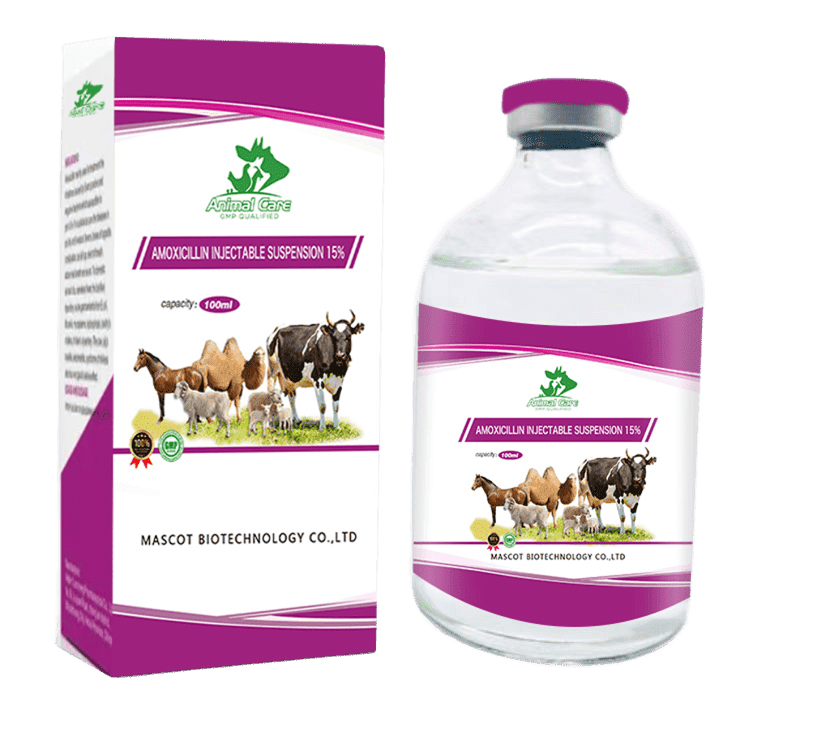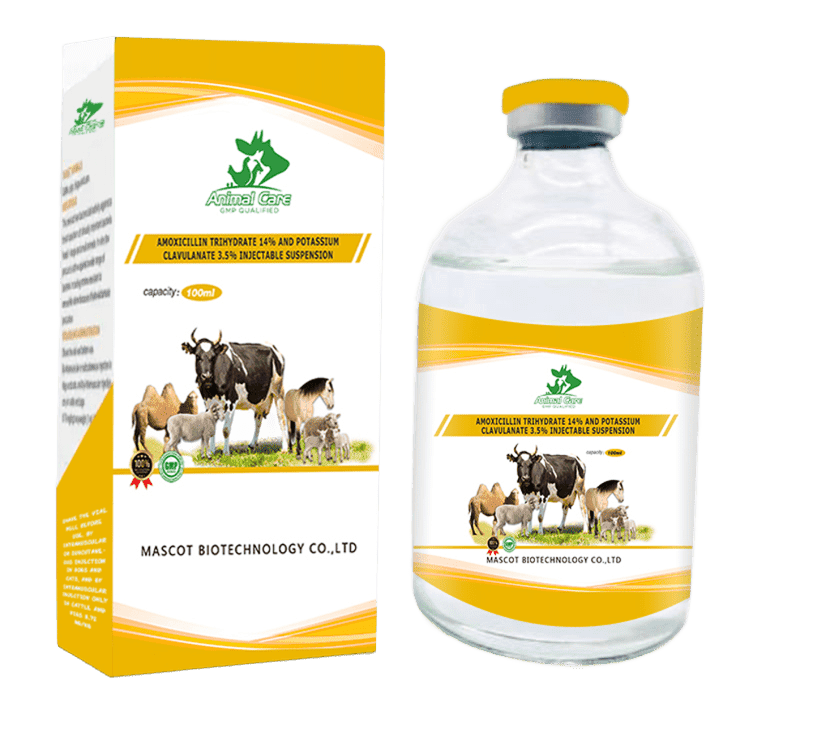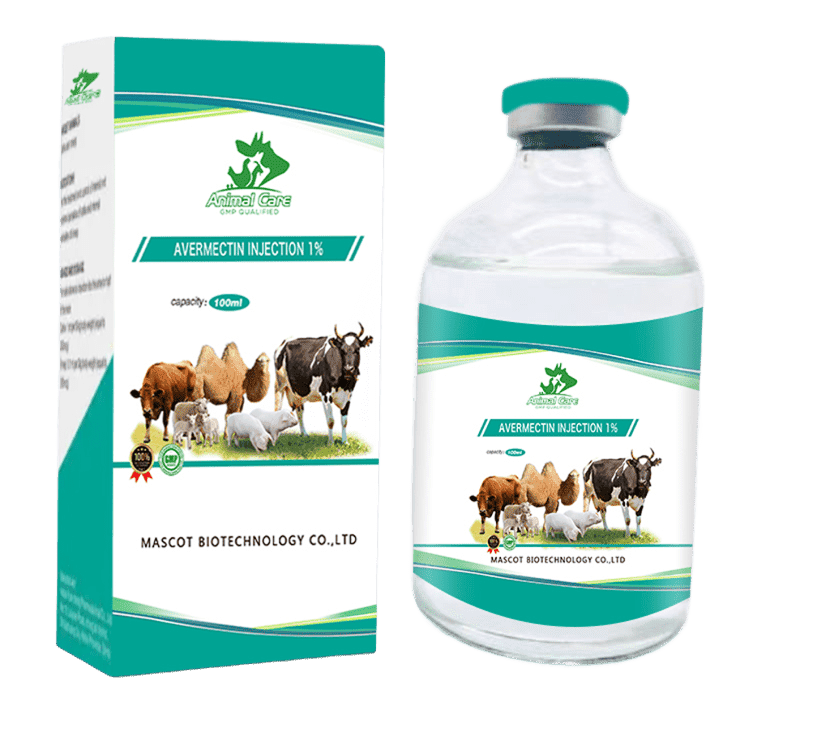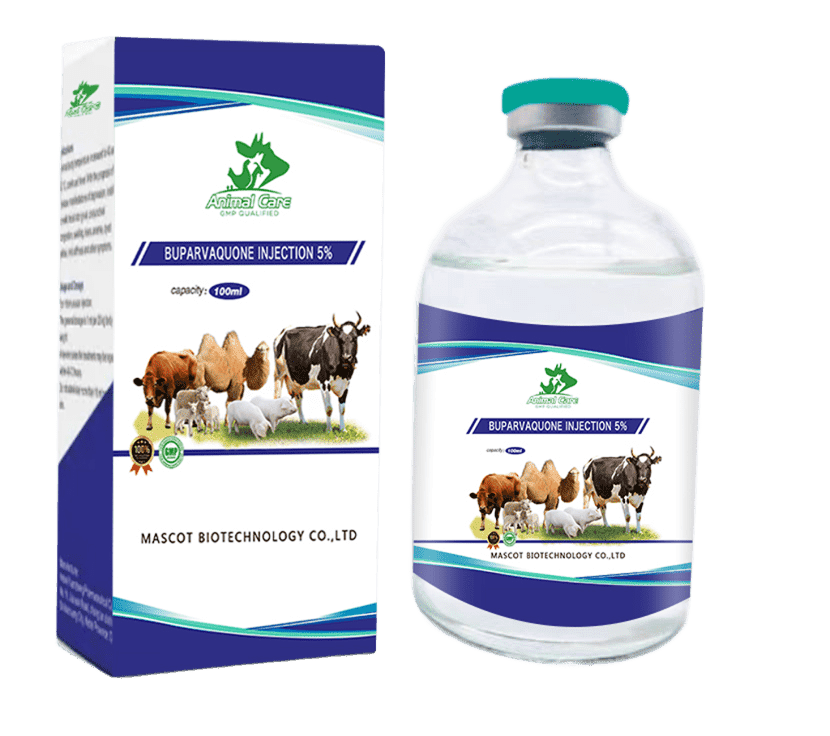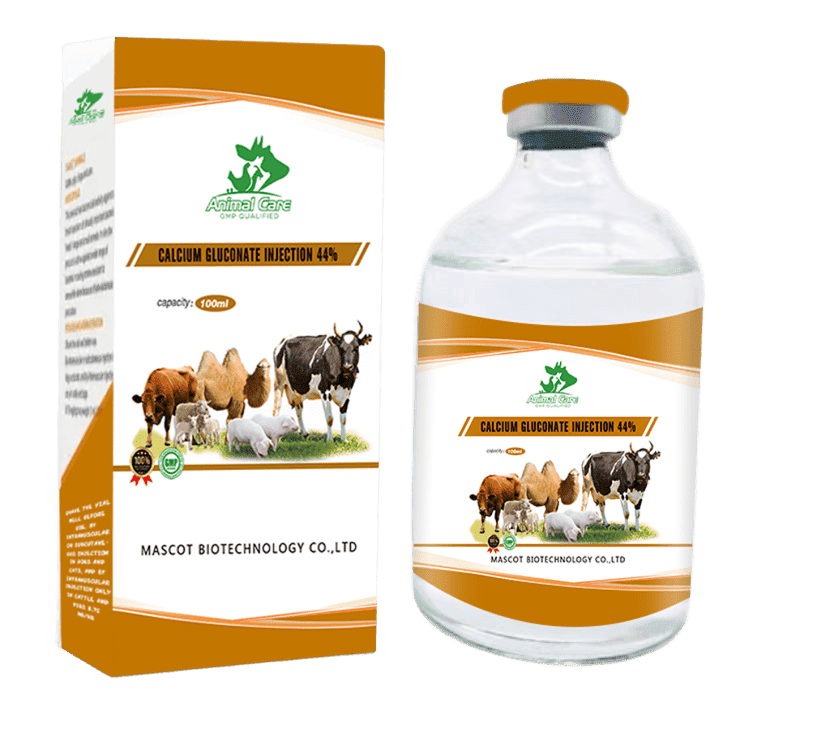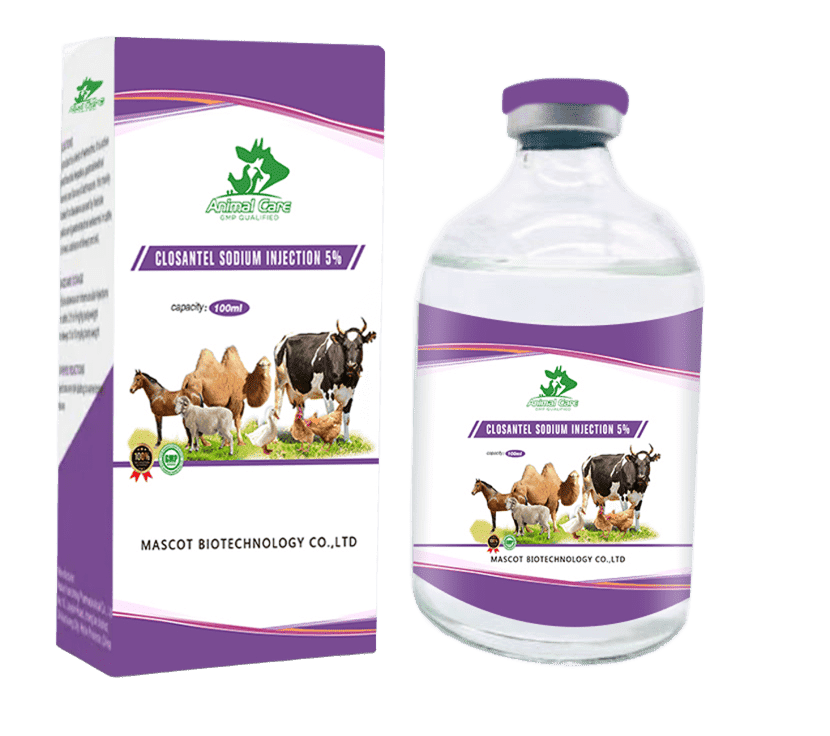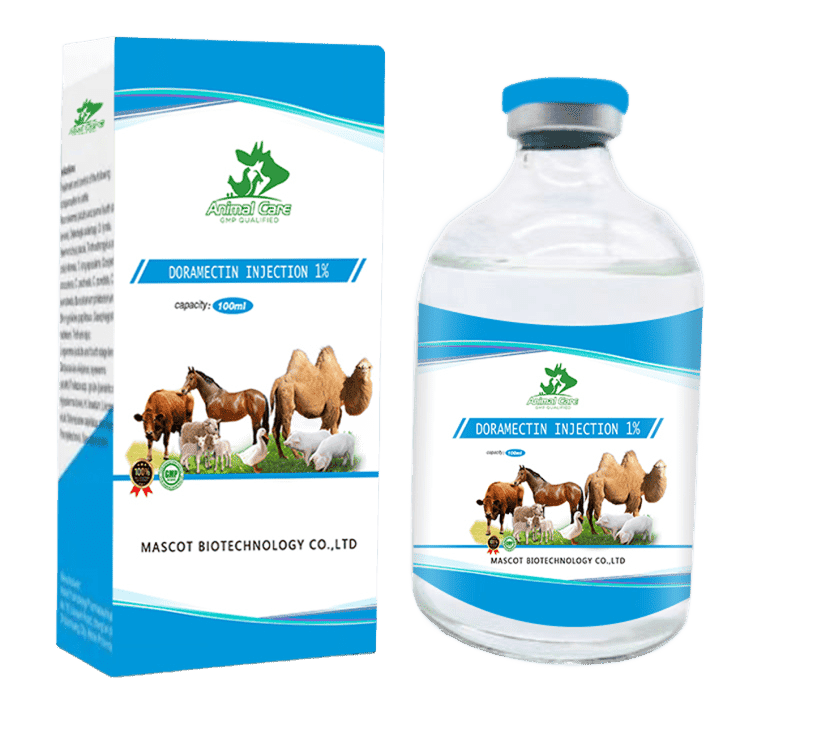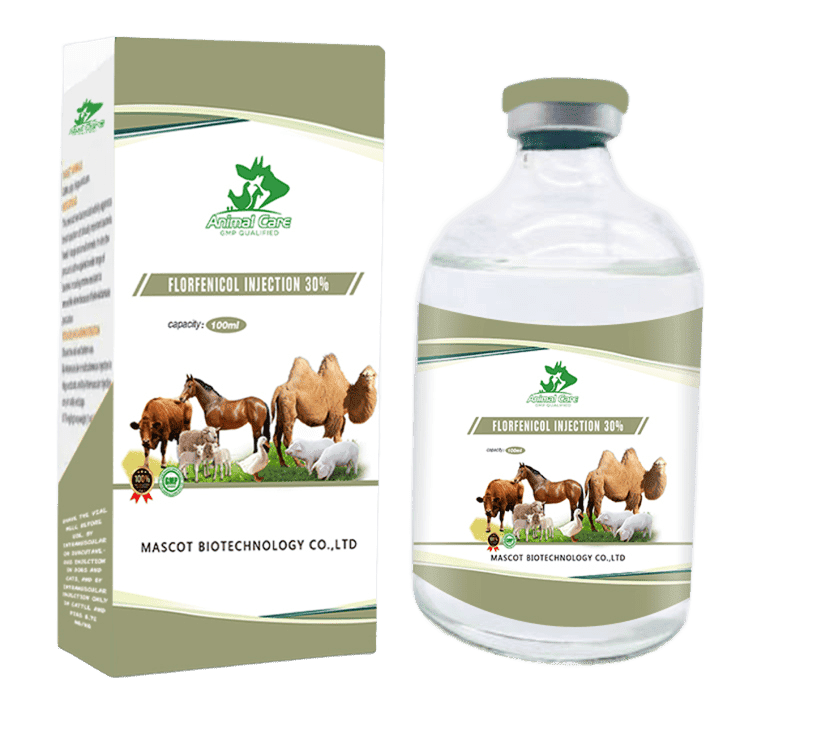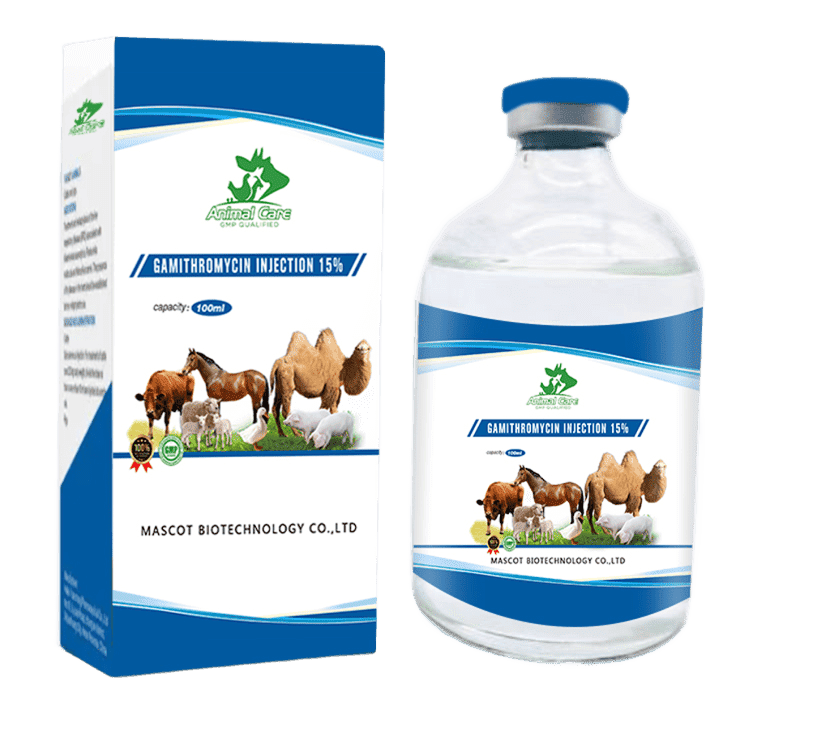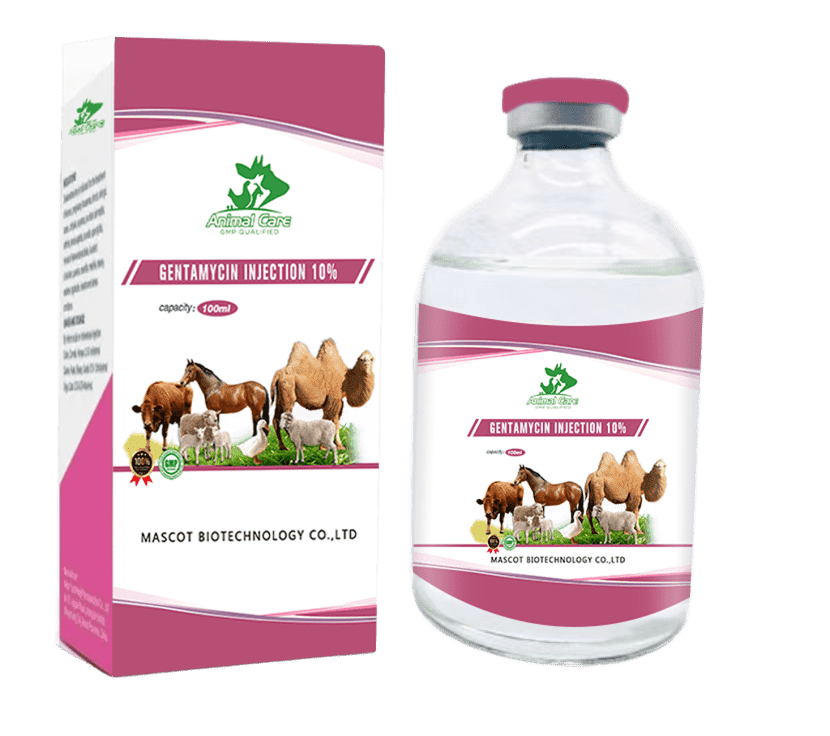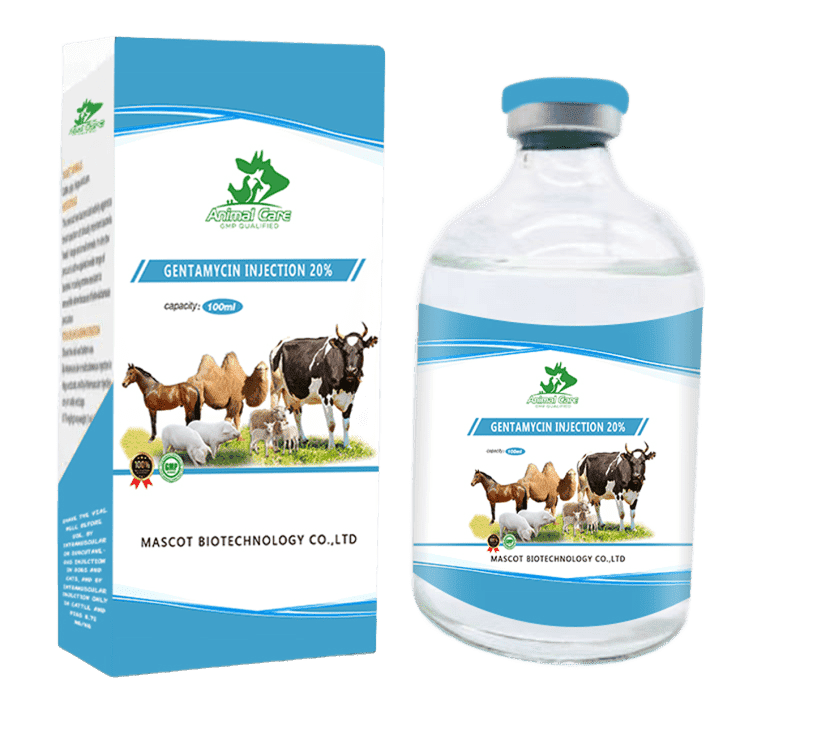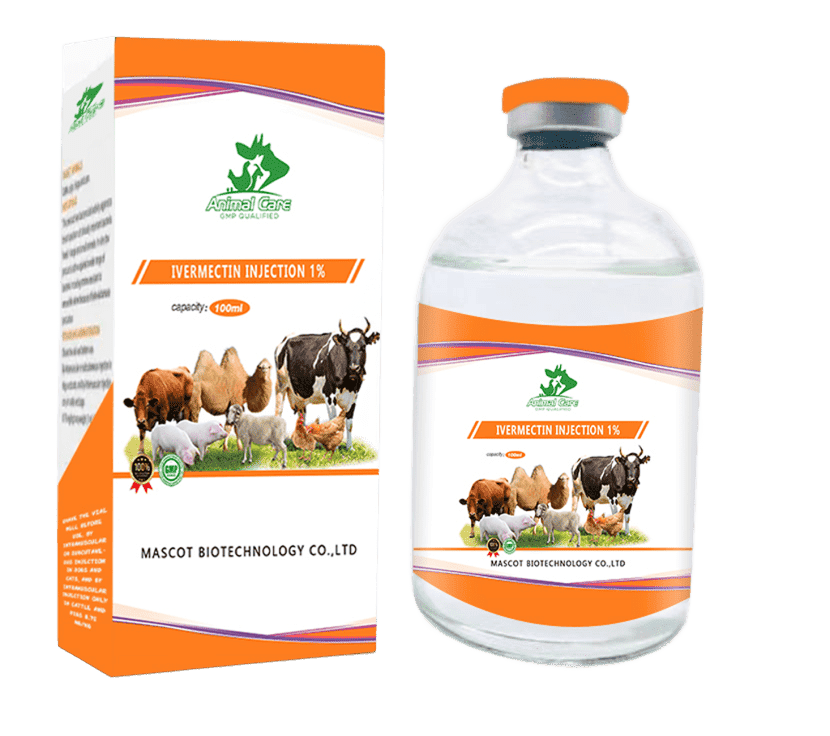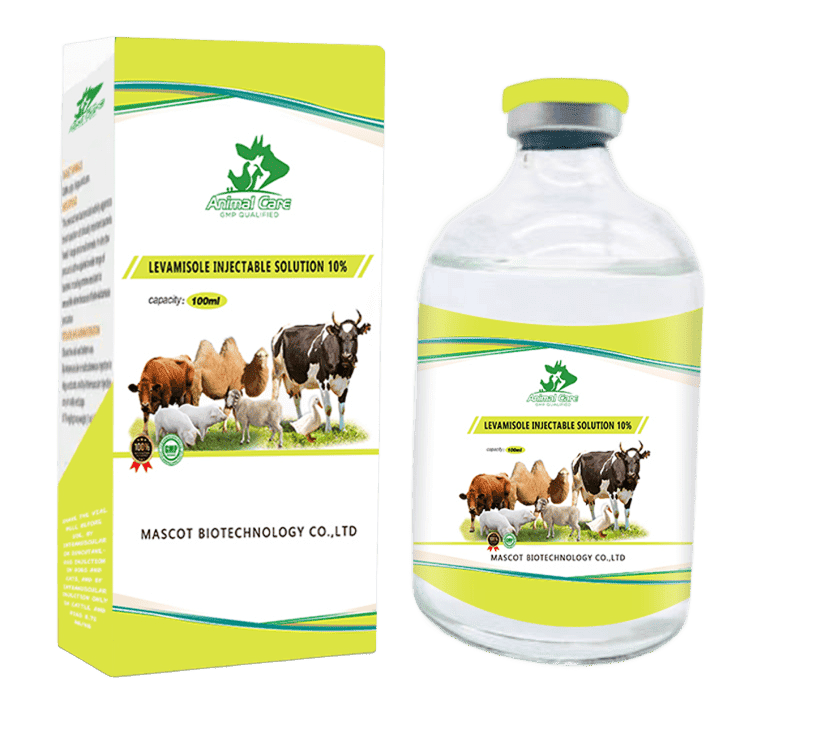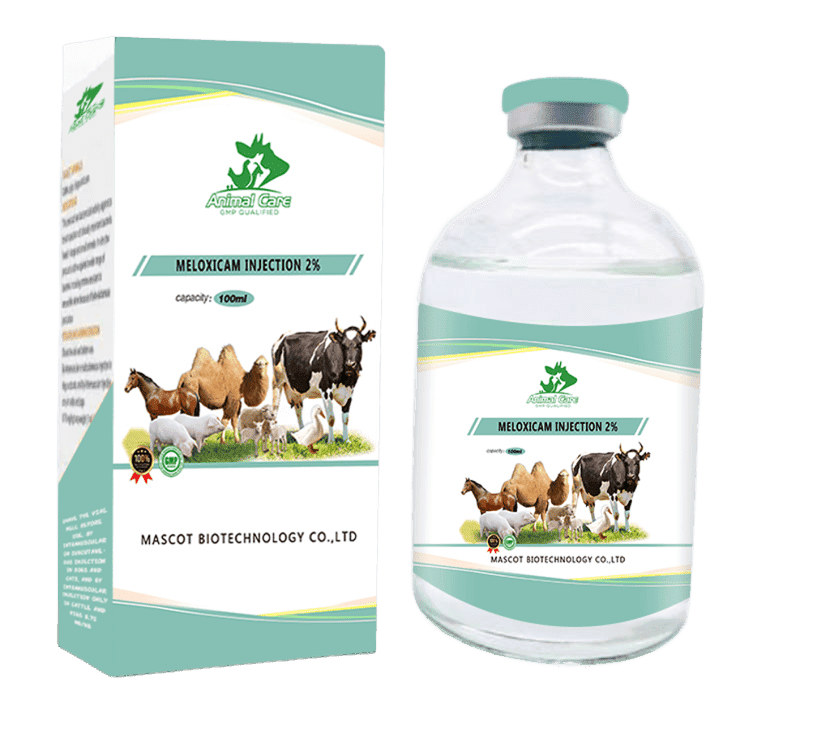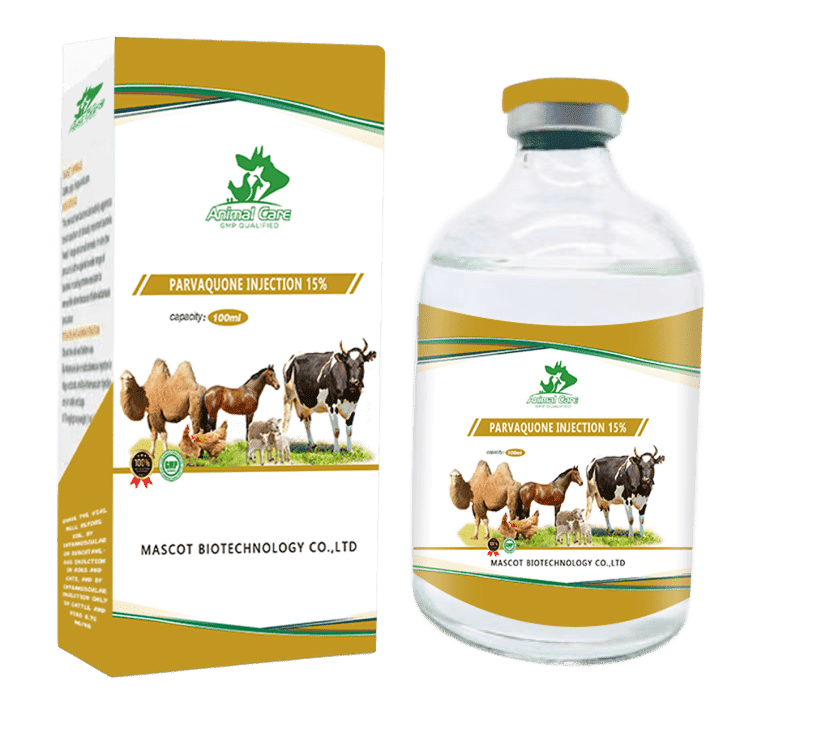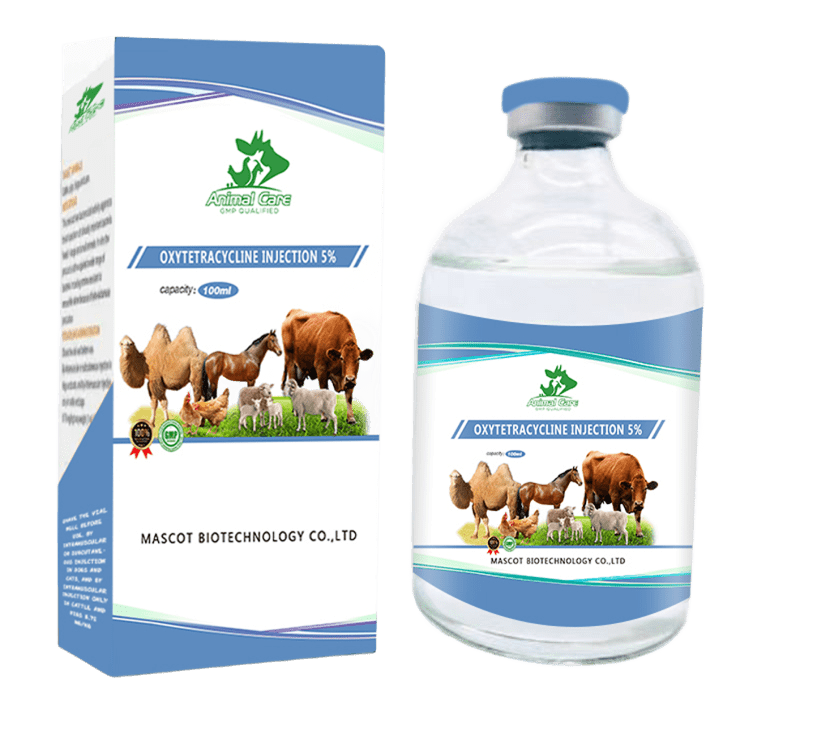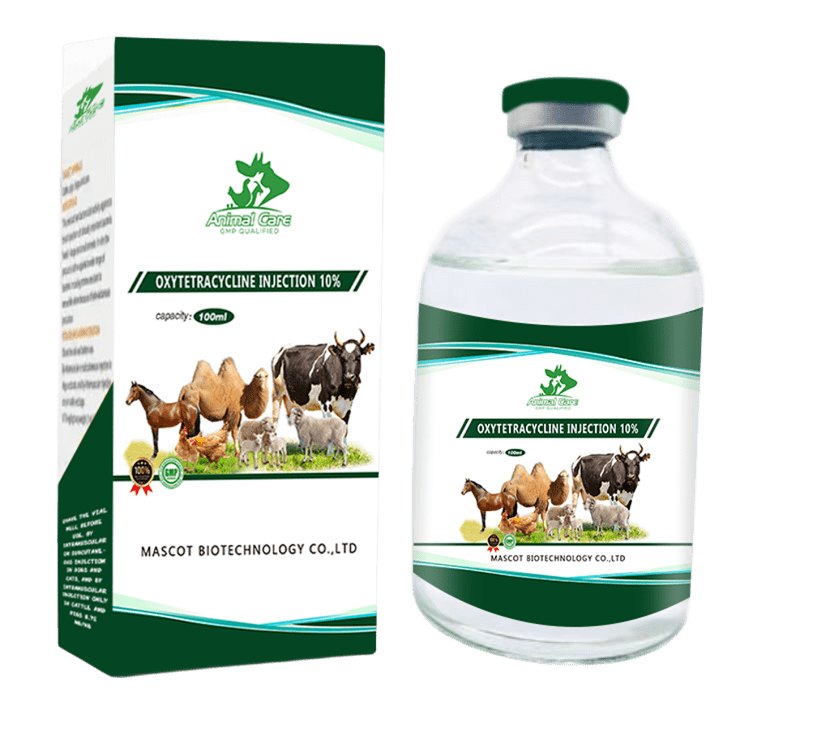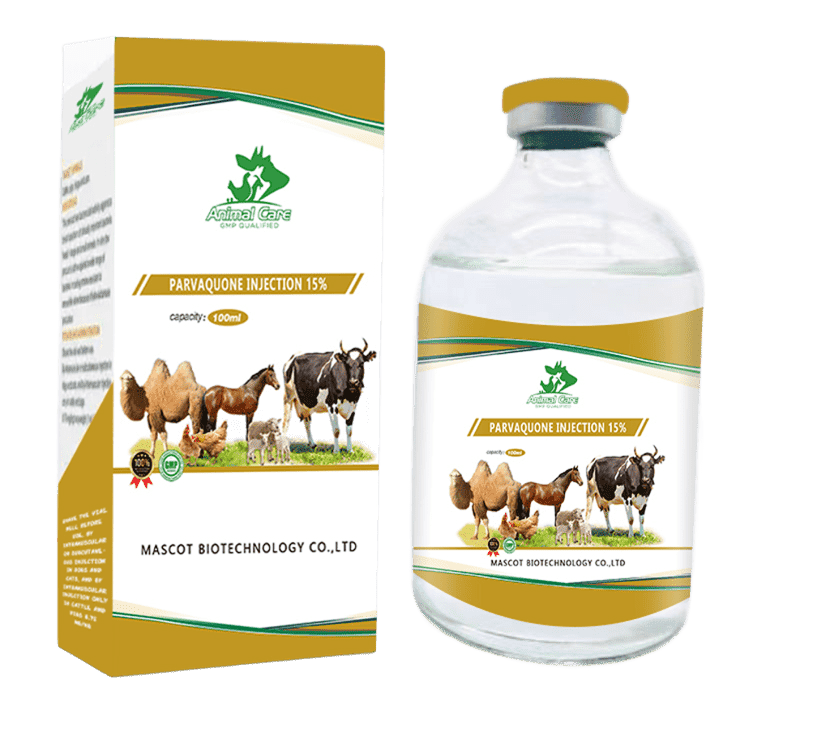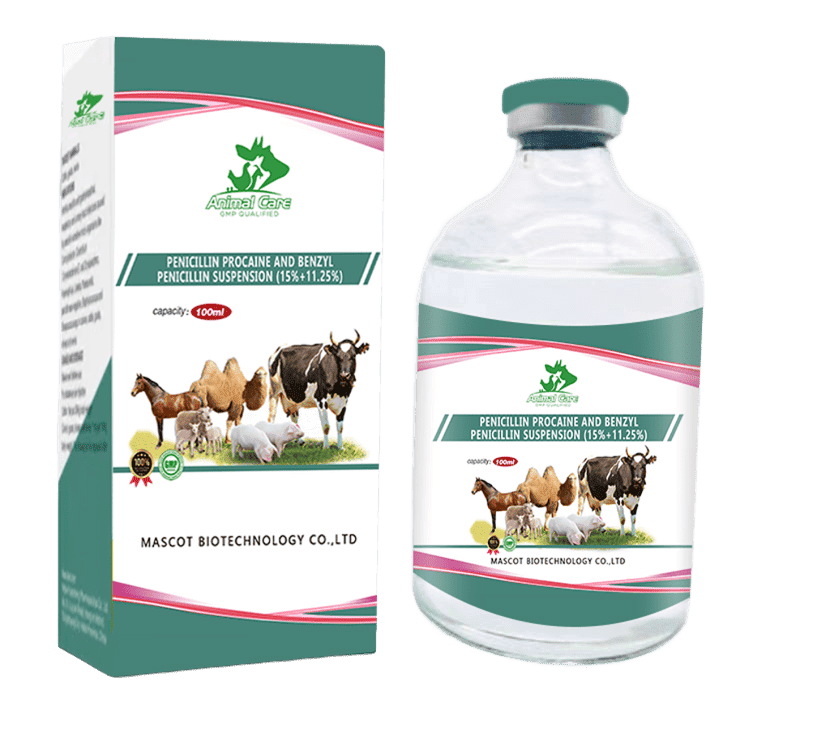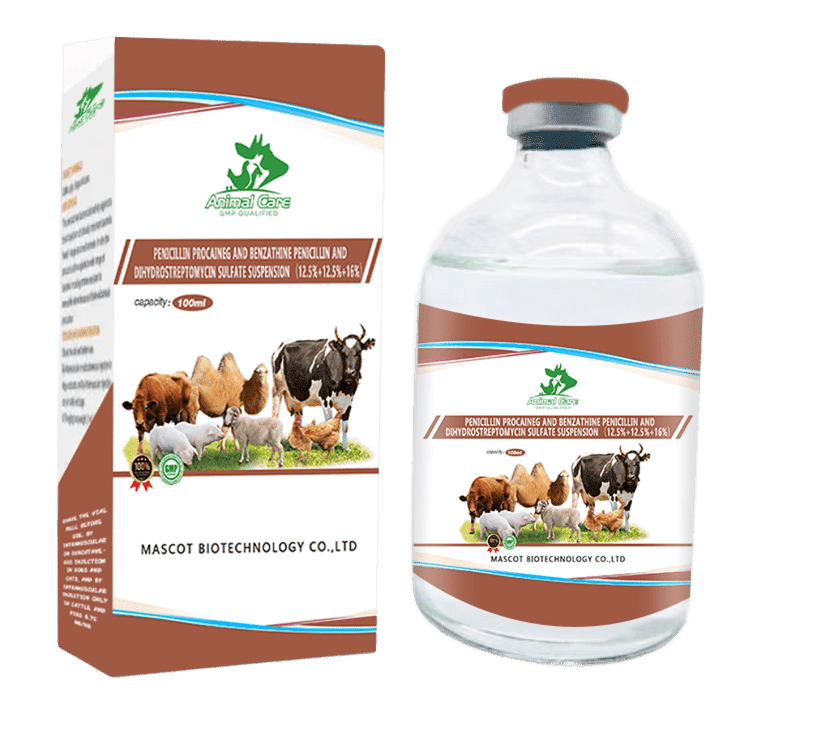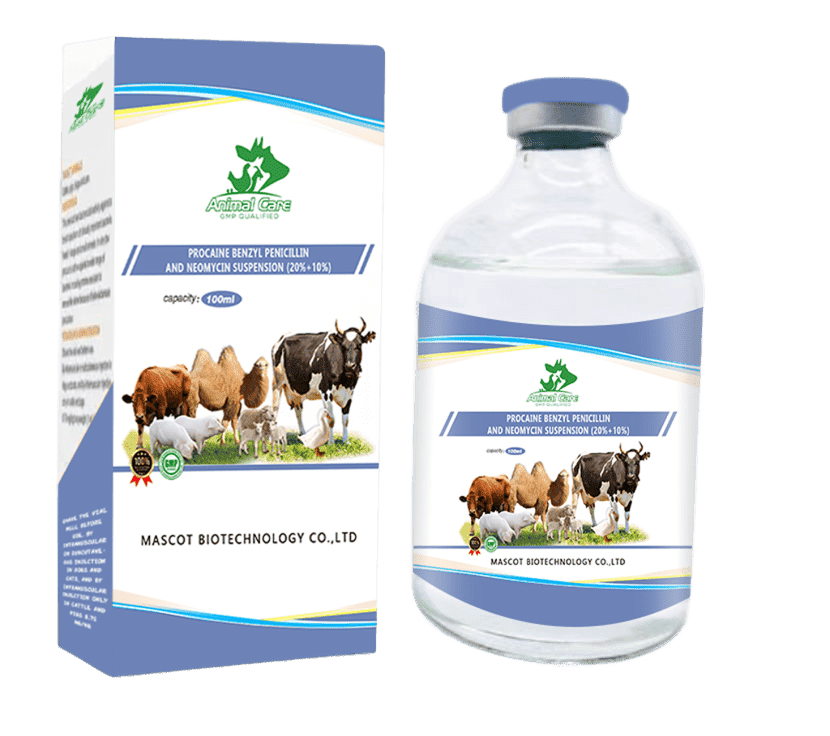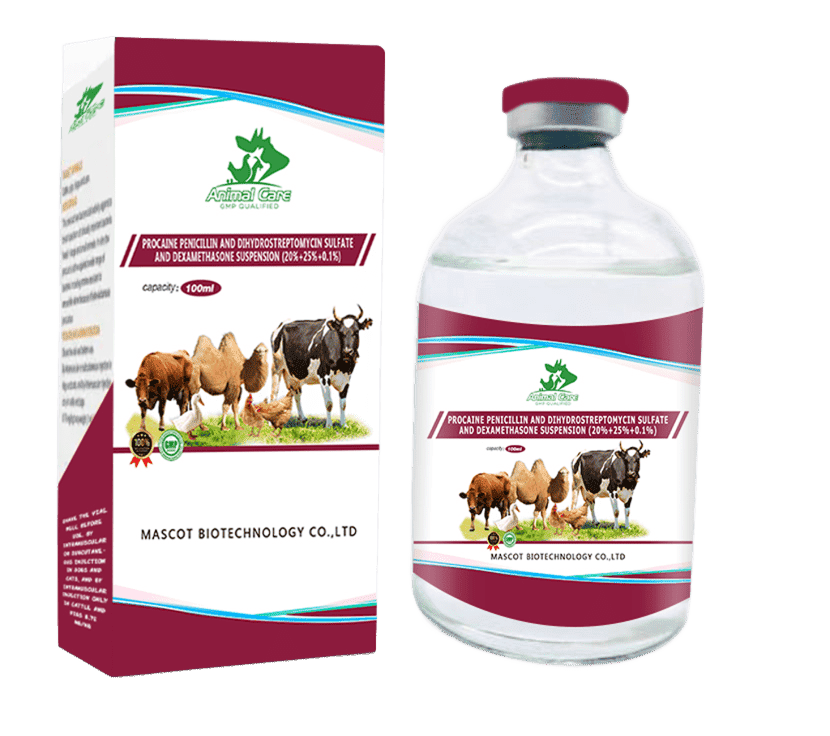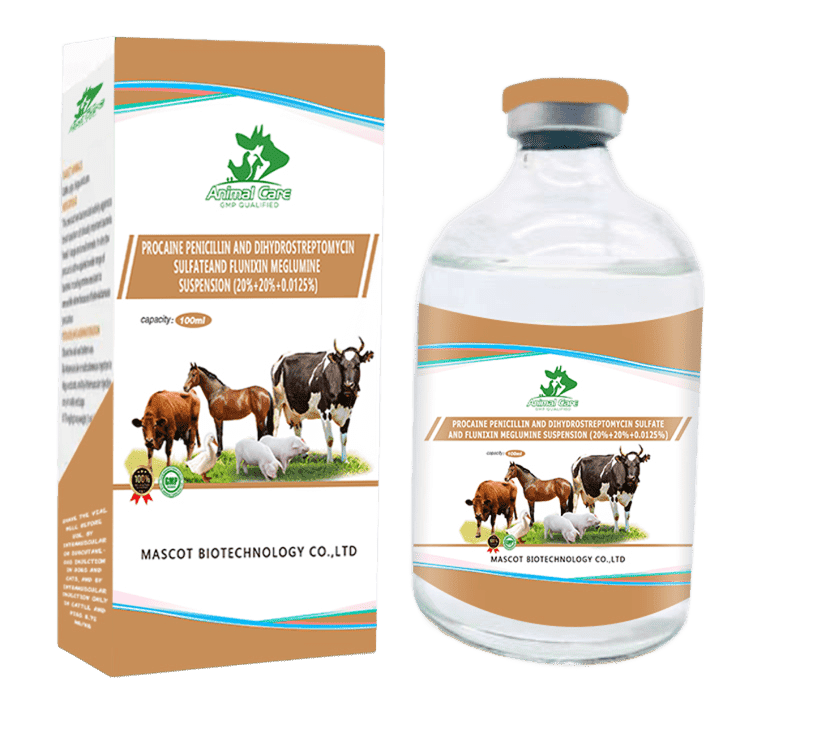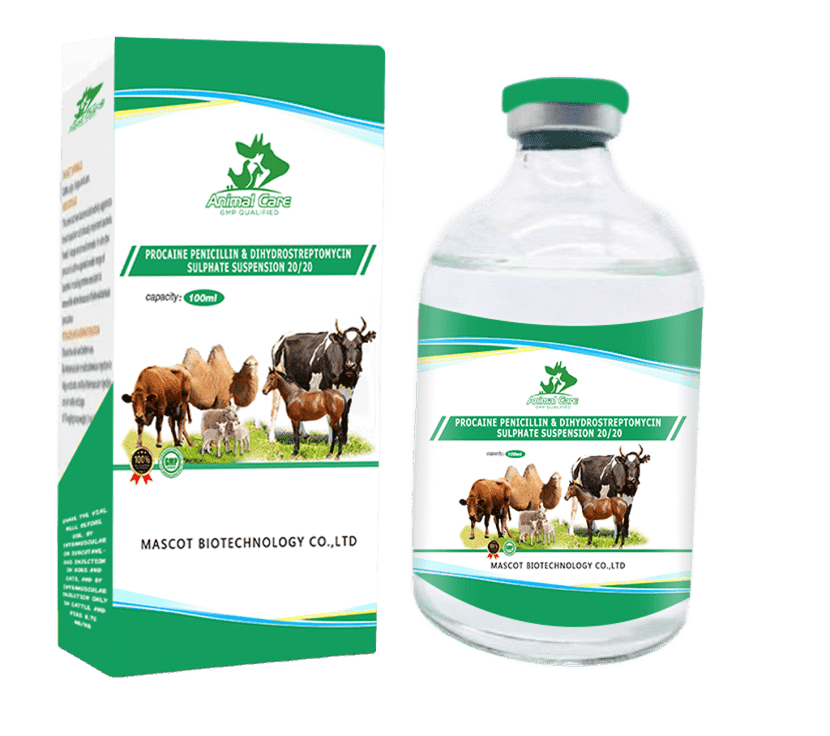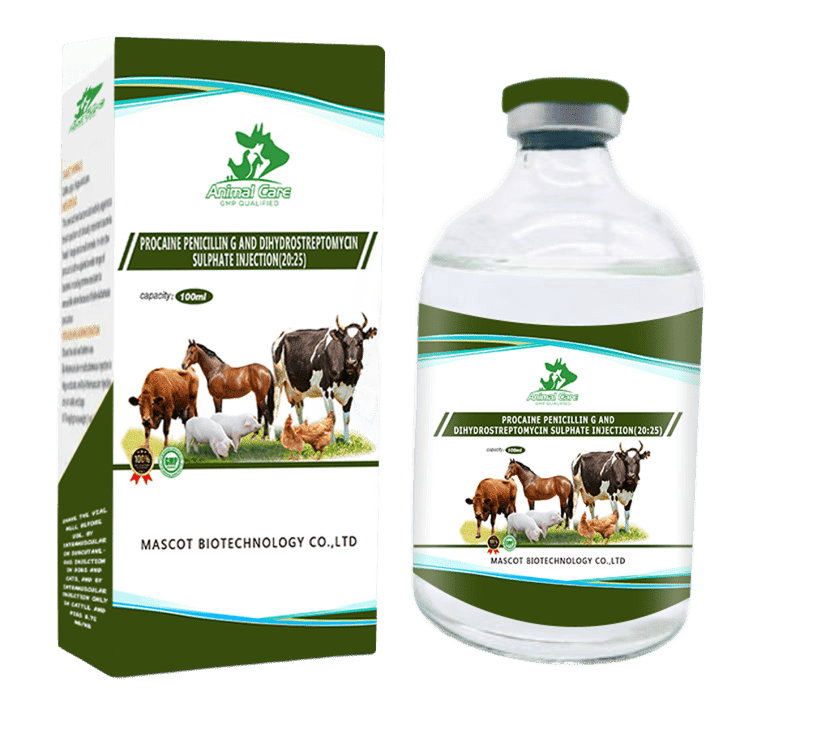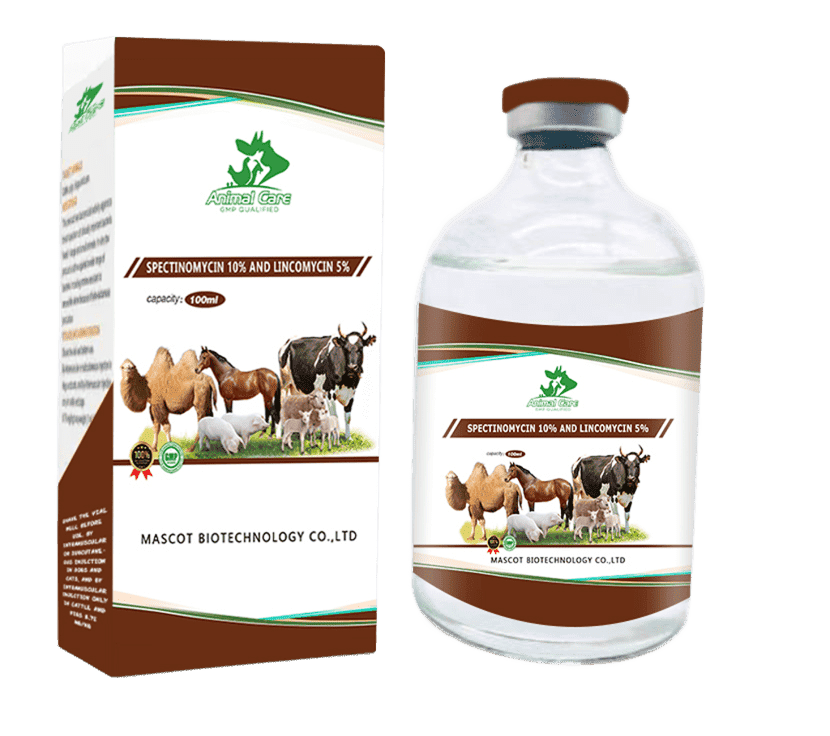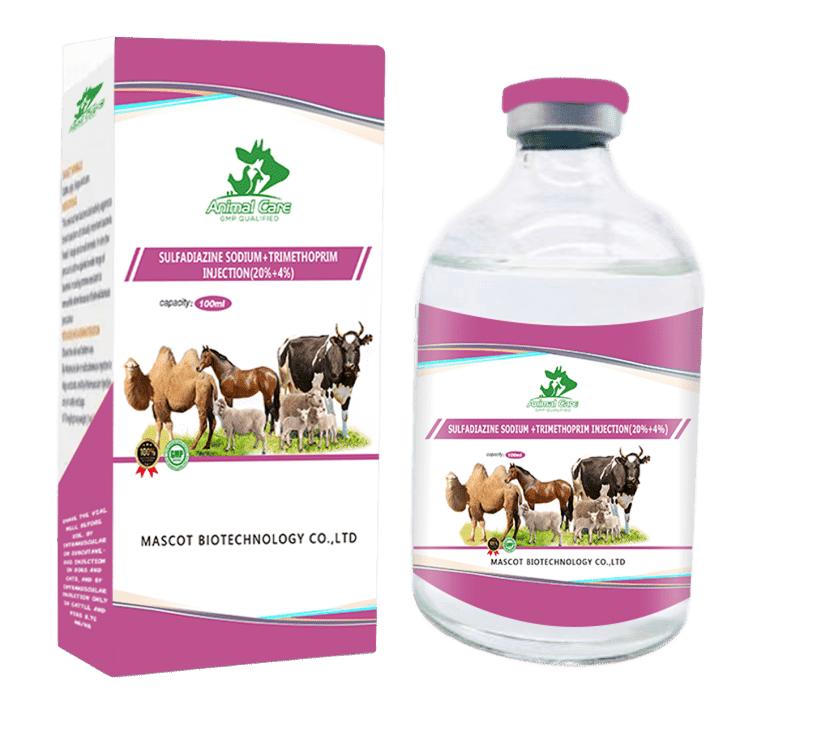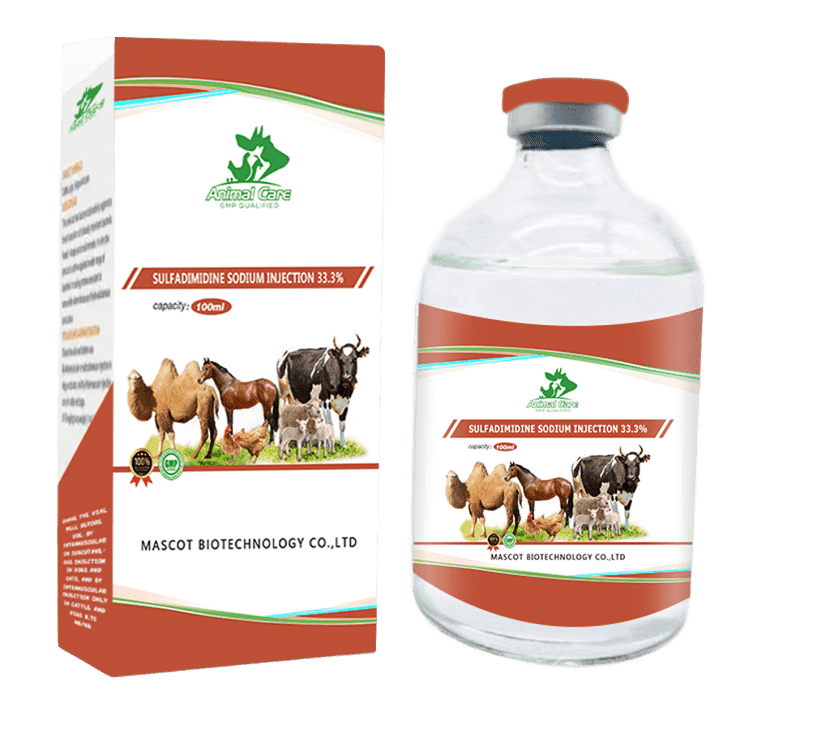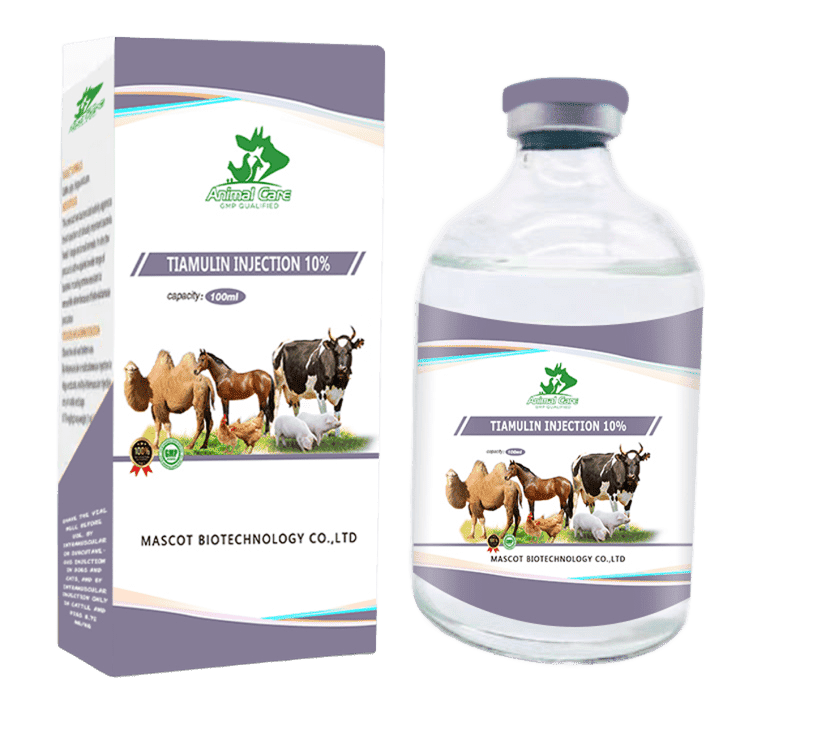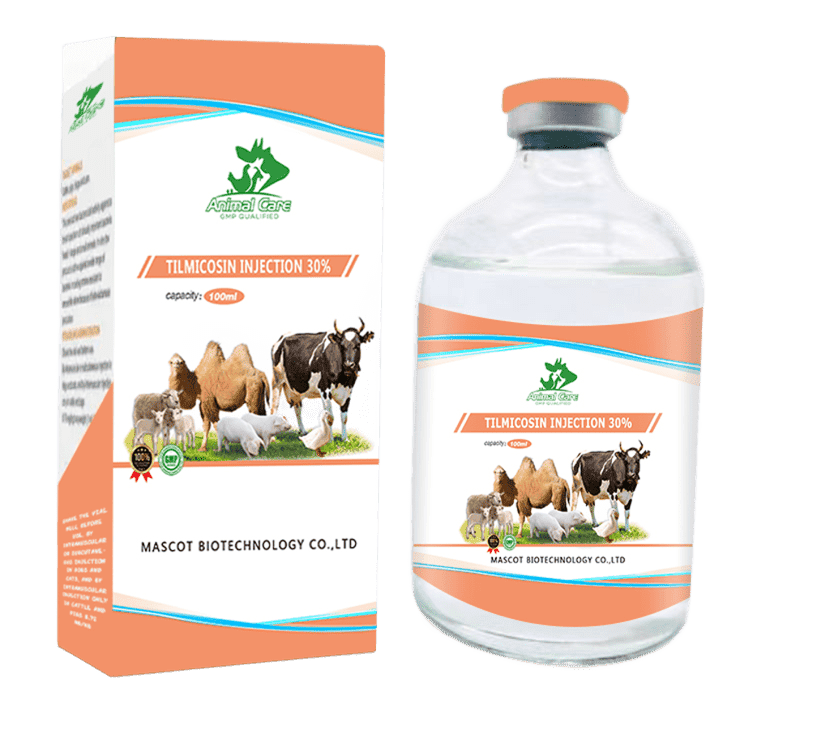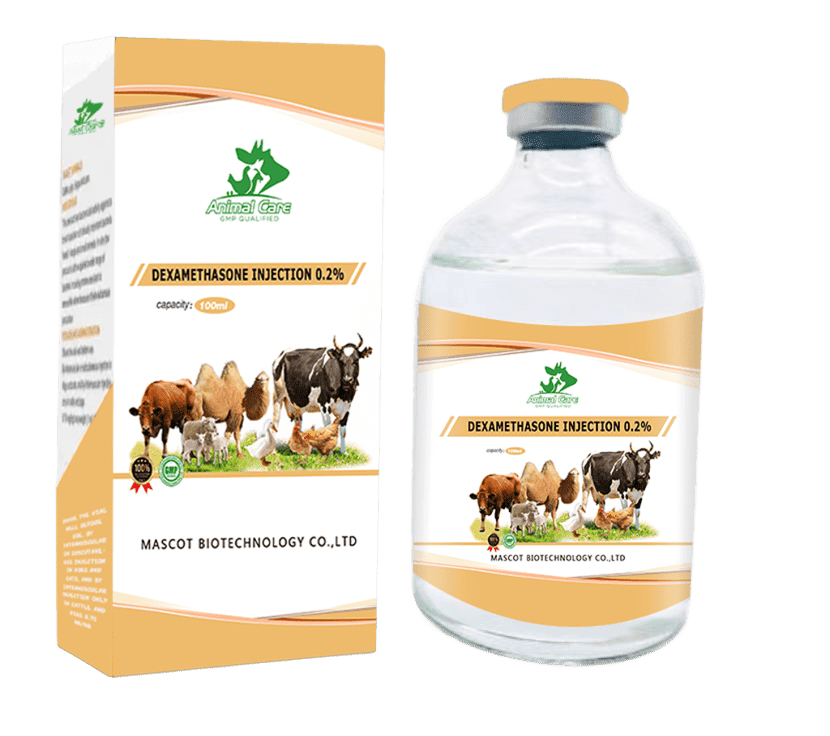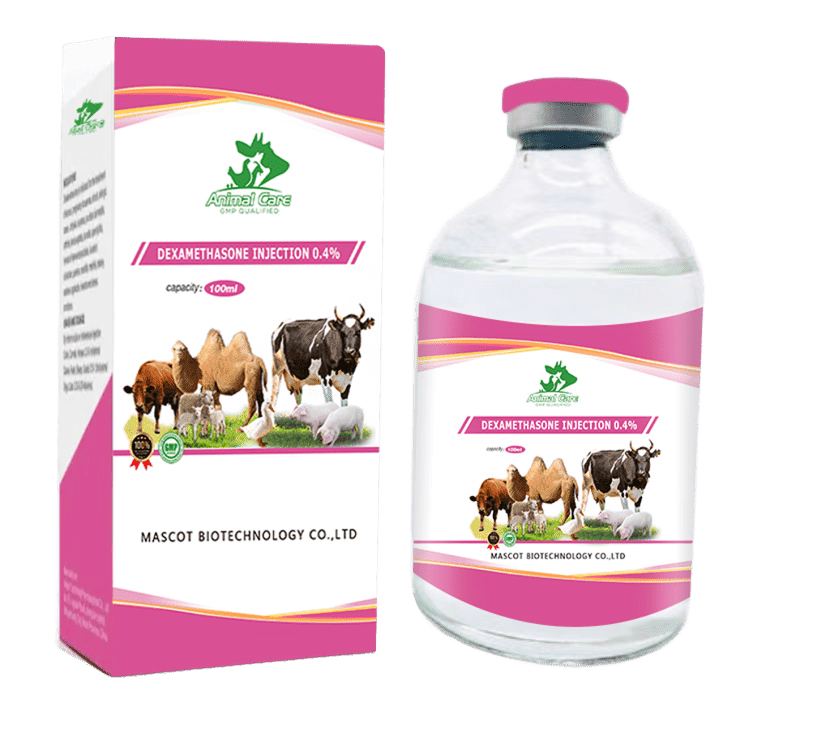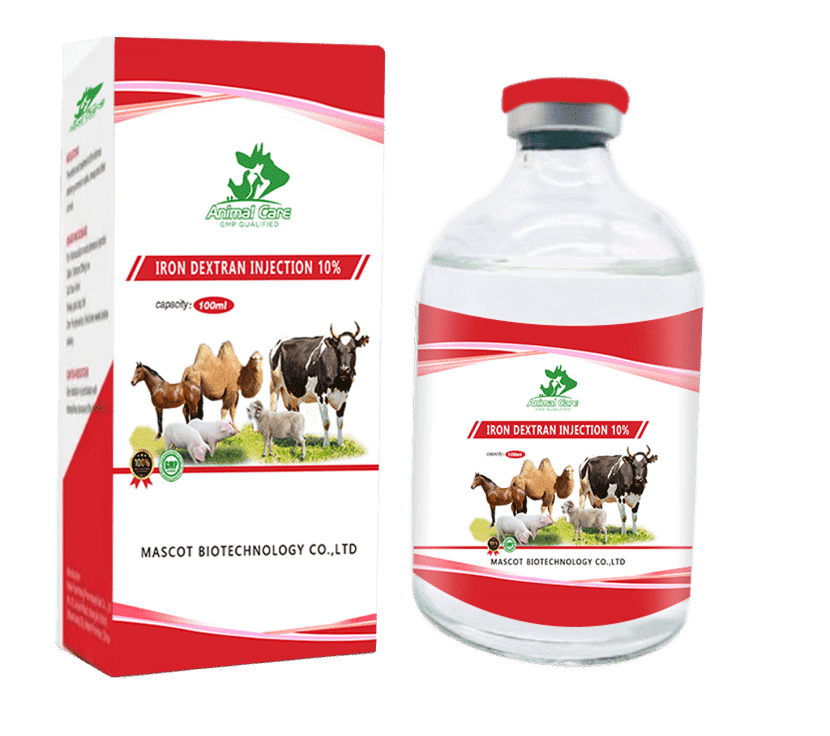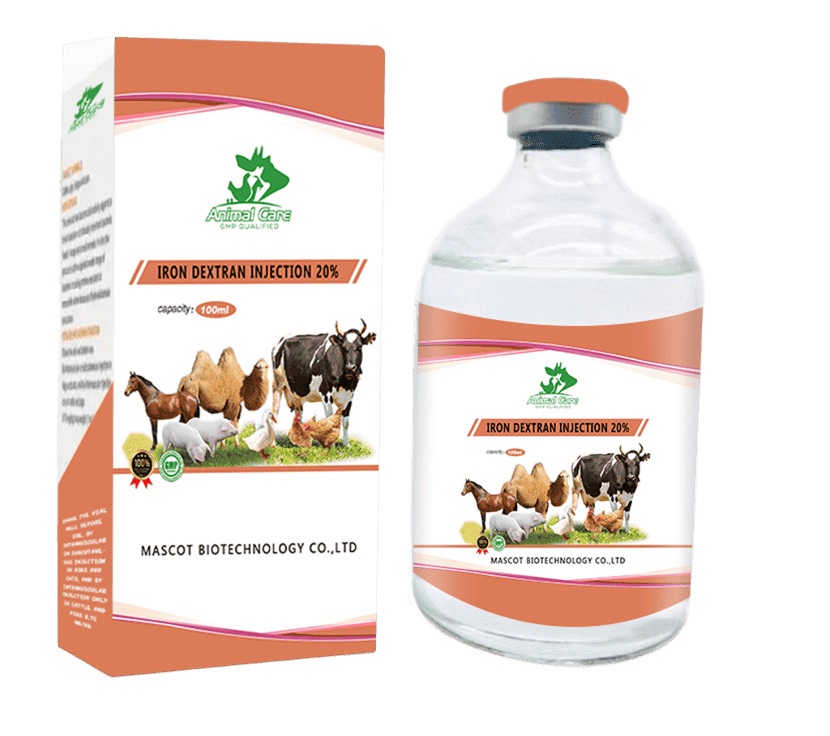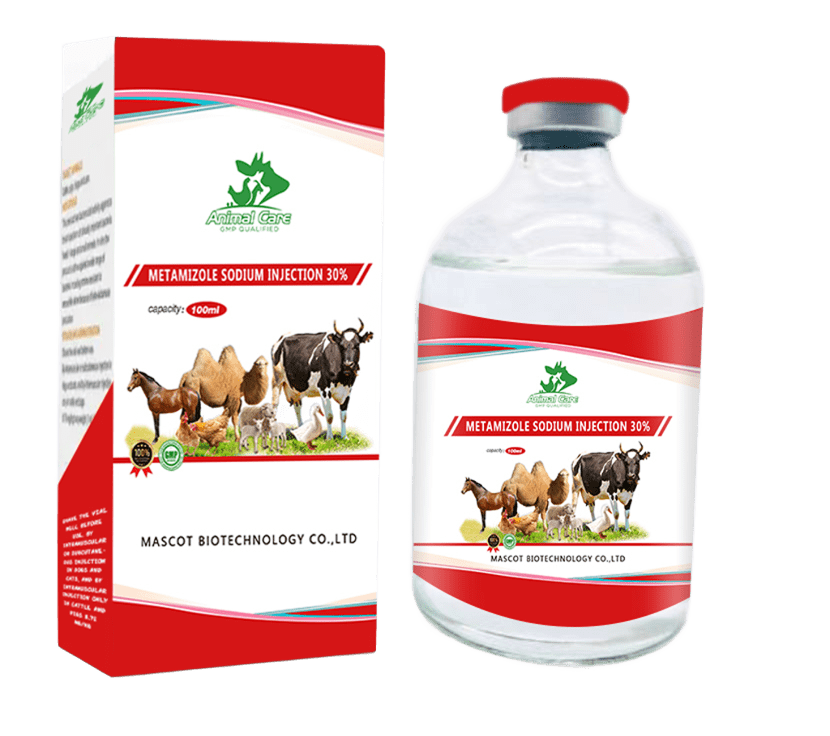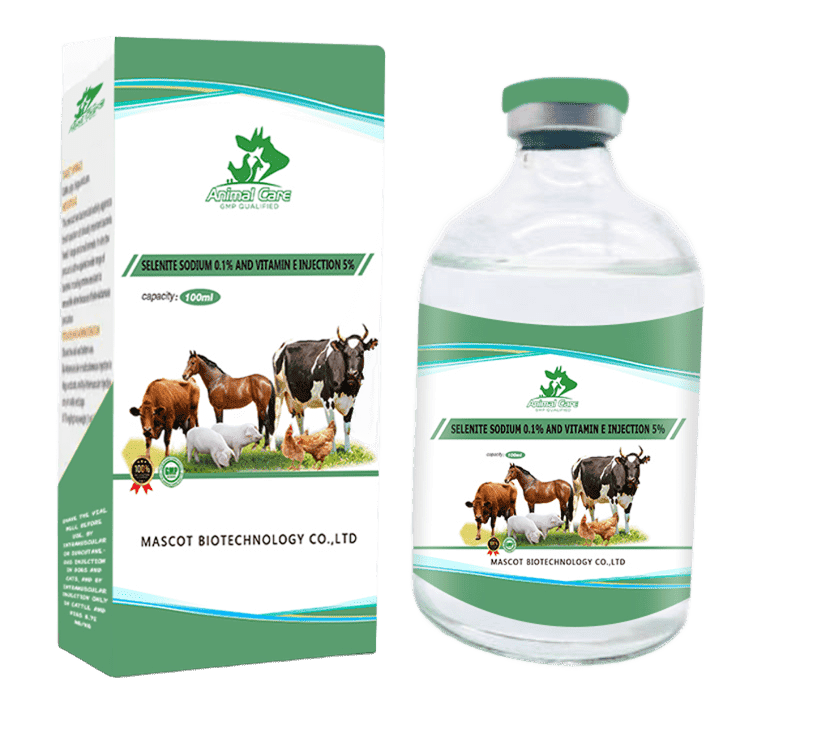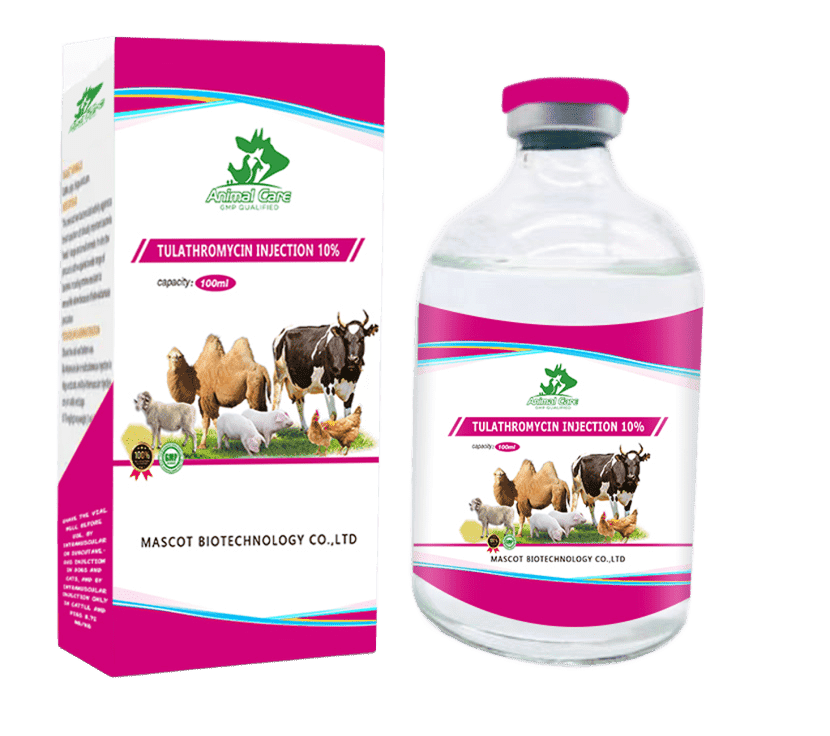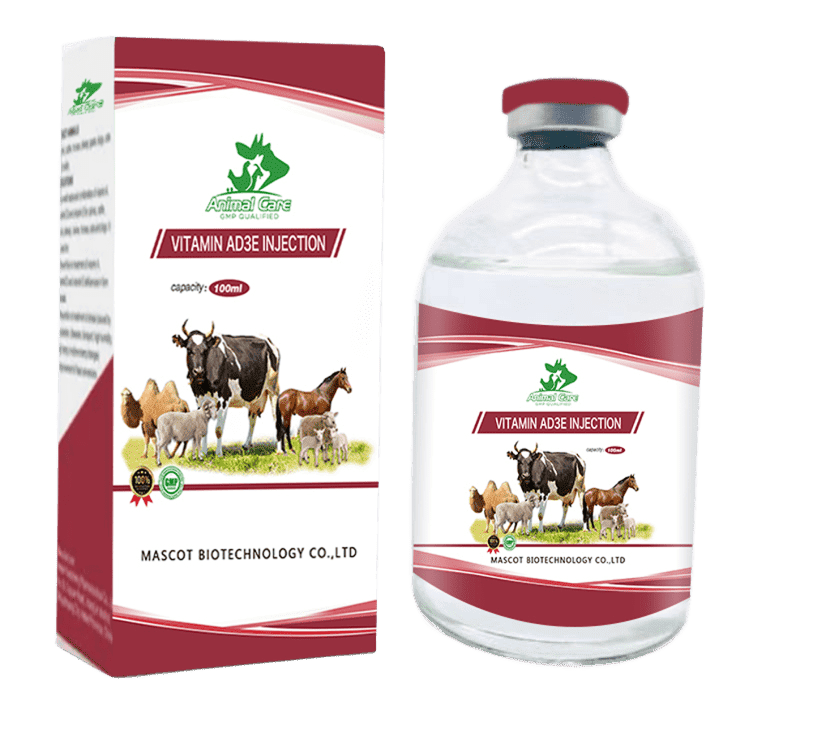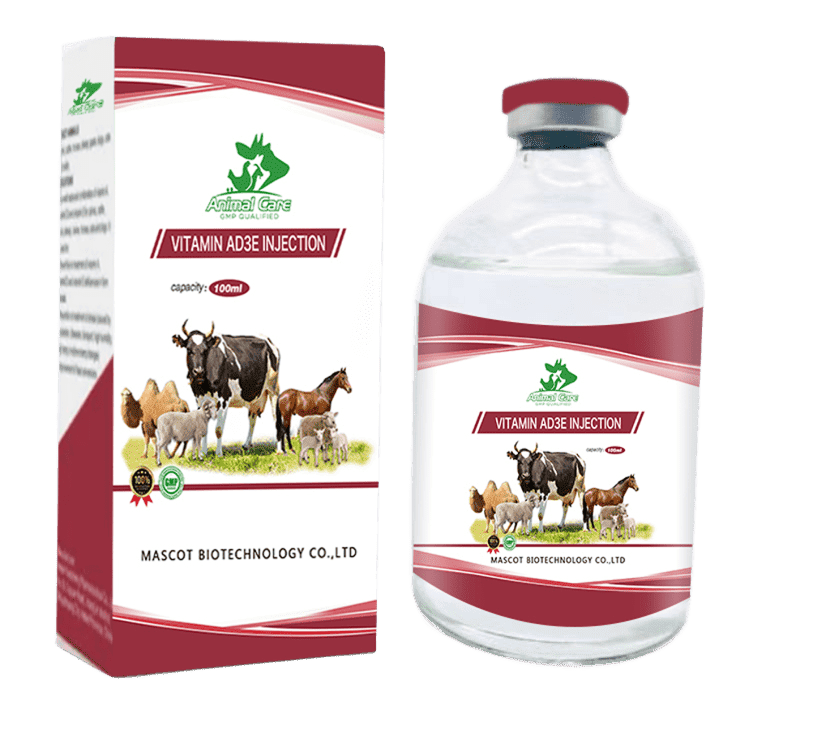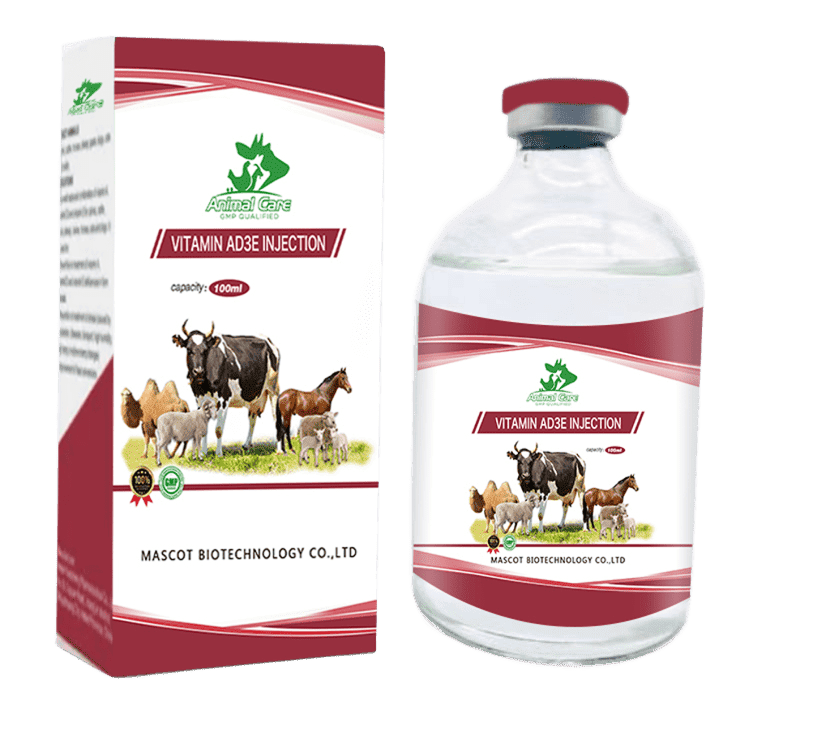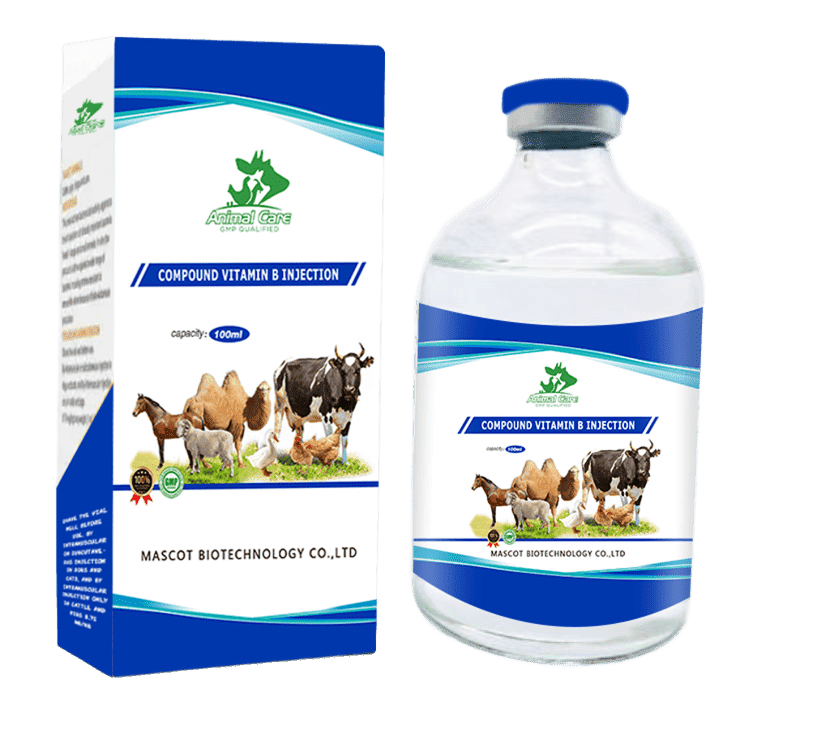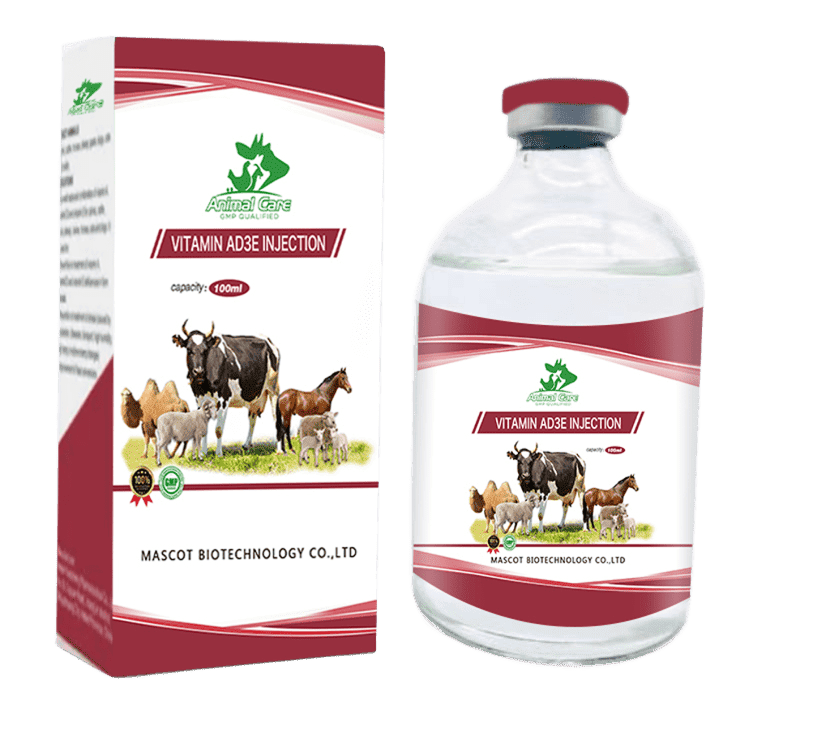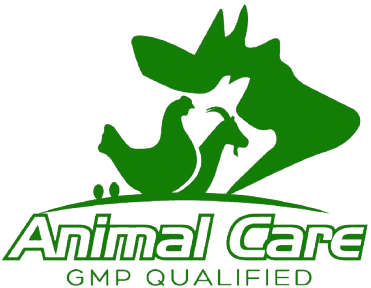Vet Liquid Injection &Vet Suspension for Injection &Vet Powder for Injection Product Catalog
Atropine Sulfate Injection Detailed
[Product Name]
Atropine Sulfate Injection
[Indications]
Atropine Sulfate Injection is indicated for the following uses:
- To relieve gastrointestinal spasms.
- To reduce glandular secretions during anesthesia.
- As an antidote for organophosphorus poisoning.
- To dilate the pupils during ocular examinations.
It is suitable for use in cattle, sheep, pigs, horses, and poultry.
[Main Ingredients]
Atropine Sulfate
[Dosage and Administration]
Administer intramuscularly, subcutaneously, or intravenously as directed by a veterinarian. The usual dosage is 0.02–0.04 mg/kg body weight. Dosage may be adjusted based on the animal’s weight, species, and condition.
[Precautions]
- Do not administer to animals with glaucoma, tachycardia, or intestinal atony.
- Avoid overdose, as it may cause side effects such as rapid heart rate, agitation, or dry mouth.
- Monitor the animal’s condition after administration, and consult a veterinarian if adverse symptoms occur.
- Use with caution in dehydrated animals due to its potential to reduce saliva production.
[Withdrawal Period]
- Meat: 7 days
- Milk: Not for use in lactating animals.
[Storage]
Store in a cool, dry place away from light, preferably at 15°C to 25°C.
[Packaging]
50 mL per vial or 100 mL per vial
Atropine Sulfate Injection Detailed
[Product Name]
Avermectin Injection
[Indications]
Avermectin Injection is indicated for the treatment and control of internal and external parasites, including:
- Gastrointestinal roundworms.
- Lungworms.
- Mites and lice.
- Ticks.
It is suitable for cattle, sheep, pigs, goats, and other livestock.
[Main Ingredients]
Avermectin
[Dosage and Administration]
Administer subcutaneously at a dose of 0.2 mg/kg body weight for internal parasites and 0.3 mg/kg body weight for external parasites. Adjust dosage based on veterinary advice and the animal’s weight.
[Precautions]
- Avoid use in animals with hypersensitivity to avermectin.
- Do not overdose, as it may cause toxicity symptoms such as tremors, incoordination, or excessive salivation.
- Ensure proper injection technique to avoid local swelling or infection.
- Do not use in animals intended for breeding within 28 days after administration.
[Withdrawal Period]
- Meat: 28 days
- Milk: Not for use in lactating animals.
[Storage]
Store in a cool, dry place away from light, preferably at 15°C to 25°C.
[Packaging]
50 mL per vial or 100 mL per vial
Let me know if you need more adjustments or if you’d like to continue with more texts!
Buparvaquone Injection Detailed
[Product Name]
Buparvaquone Injection
[Indications]
Buparvaquone Injection is used for the treatment of parasitic infections caused by:
- Babesiosis (Babesia spp.).
- Theileriosis (Theileria spp.).
It is suitable for use in cattle, sheep, goats, and other ruminants.
[Main Ingredients]
Buparvaquone
[Dosage and Administration]
Administer intramuscularly at a dose of 2.5 mg/kg body weight. In severe cases, a second dose may be administered 48 hours later. Adjust dosage based on veterinary guidance and the animal’s condition.
[Precautions]
- Shake well before use.
- Do not administer to animals with liver or kidney impairment.
- Avoid overdosage to prevent side effects such as hypersensitivity or local swelling at the injection site.
- Minimize stress or exertion during treatment.
[Withdrawal Period]
- Meat: 42 days
- Milk: Not for use in lactating animals.
[Storage]
Store in a cool, dry place away from light, preferably at 15°C to 25°C.
[Packaging]
50 mL per vial or 100 mL per vial
Let me know if you need further modifications or more texts formatted!
Calcium Borogluconate Injection Detailed
[Product Name]
Calcium Borogluconate Injection
[Indications]
Calcium Borogluconate Injection is used to treat and prevent calcium deficiencies, particularly in cases of:
- Hypocalcemia (milk fever) in dairy cows, sheep, and goats.
- Calcium deficiency during lactation in dairy animals.
It is suitable for use in cattle, sheep, goats, and other ruminants.
[Main Ingredients]
Calcium Borogluconate
[Dosage and Administration]
Administer intravenously or subcutaneously, based on the animal’s body weight and condition. The recommended dosage for dairy cows is 500 mL for cows weighing 500–600 kg. The dose should be adjusted based on the severity of the calcium deficiency and the animal’s size.
[Precautions]
- Do not administer too quickly, as rapid administration may cause cardiovascular side effects.
- Avoid administering to animals with heart disease or arrhythmias.
- Monitor animals after injection for signs of improved calcium levels or potential adverse effects.
[Withdrawal Period]
- Meat: 7 days
- Milk: 48 hours
[Storage]
Store in a cool, dry place away from light, preferably at 15°C to 25°C.
[Packaging]
500 mL per vial or 1 L per vial
Let me know if you need further changes or additional texts formatted!
Calcium Borogluconate Injection Detailed
[Product Name]
Calcium Borogluconate Injection
[Indications]
Calcium Borogluconate Injection is used to treat and prevent calcium deficiencies, particularly in cases of:
- Hypocalcemia (milk fever) in dairy cows, sheep, and goats.
- Calcium deficiency during lactation in dairy animals.
It is suitable for use in cattle, sheep, goats, and other ruminants.
[Main Ingredients]
Calcium Borogluconate
[Dosage and Administration]
Administer intravenously or subcutaneously, based on the animal’s body weight and condition. The recommended dosage for dairy cows is 500 mL for cows weighing 500–600 kg. The dose should be adjusted based on the severity of the calcium deficiency and the animal’s size.
[Precautions]
- Do not administer too quickly, as rapid administration may cause cardiovascular side effects.
- Avoid administering to animals with heart disease or arrhythmias.
- Monitor animals after injection for signs of improved calcium levels or potential adverse effects.
[Withdrawal Period]
- Meat: 7 days
- Milk: 48 hours
[Storage]
Store in a cool, dry place away from light, preferably at 15°C to 25°C.
[Packaging]
500 mL per vial or 1 L per vial
Let me know if you need more changes or additional formatting!
Calcium Gluconate Injection Detailed
[Product Name]
Calcium Gluconate Injection
[Indications]
For the treatment and prevention of hypocalcemia in animals, including:
- Postpartum hypocalcemia (milk fever in dairy cows).
- Muscle spasms or convulsions caused by calcium deficiency.
- Muscle weakness, abnormal bone growth, or rickets.
Suitable for cattle, sheep, pigs, horses, and other livestock.
[Main Ingredients]
Calcium Gluconate
[Dosage and Administration]
Administer intravenously or subcutaneously under veterinary guidance. Typical dosage recommendations:
- Adult cattle: 500–800 mL, adjusted based on body weight and condition.
- Sheep or pigs: 50–100 mL.
[Precautions]
- Inject slowly to avoid arrhythmias or heart failure.
- Monitor animals after administration for any signs of allergic reactions.
- Avoid use in animals with hypercalcemia or severe renal dysfunction.
[Withdrawal Period]
- Meat: 7 days
- Milk: 48 hours
[Storage]
Store in a cool, dry place away from light, at 15°C to 25°C.
[Packaging]
100 mL per vial, 500 mL per vial
Let me know if you need any adjustments or more texts formatted!
Ciprofloxacin Injection Detailed
[Product Name]
Calcium Gluconate Injection
[Indications]
For the treatment and prevention of hypocalcemia in animals, including:
- Postpartum hypocalcemia (milk fever in dairy cows).
- Muscle spasms or convulsions caused by calcium deficiency.
- Muscle weakness, abnormal bone growth, or rickets.
Suitable for cattle, sheep, pigs, horses, and other livestock.
[Main Ingredients]
Calcium Gluconate
[Dosage and Administration]
Administer intravenously or subcutaneously under veterinary guidance. Typical dosage recommendations:
- Adult cattle: 500–800 mL, adjusted based on body weight and condition.
- Sheep or pigs: 50–100 mL.
[Precautions]
- Inject slowly to avoid arrhythmias or heart failure.
- Monitor animals after administration for any signs of allergic reactions.
- Avoid use in animals with hypercalcemia or severe renal dysfunction.
[Withdrawal Period]
- Meat: 7 days
- Milk: 48 hours
[Storage]
Store in a cool, dry place away from light, at 15°C to 25°C.
[Packaging]
100 mL per vial, 500 mL per vial
Let me know if you need any adjustments or more texts formatted!
Closantel Sodium Injection Detailed
[Product Name]
Closantel Sodium Injection
[Indications]
Closantel Sodium Injection is used for the treatment and control of parasitic infections, including:
- Liver fluke infestations (Fasciola spp.).
- Gastrointestinal roundworms.
- Lungworms.
It is suitable for cattle, sheep, goats, and other livestock.
[Main Ingredients]
Closantel Sodium
[Dosage and Administration]
Administer subcutaneously at a dose of 2.5 mg/kg body weight. The dose may be repeated 2–3 weeks later for further control of liver flukes.
[Precautions]
- Do not use in animals with a known hypersensitivity to Closantel.
- Do not use in pregnant animals in the early stages of pregnancy.
- Overdosage may cause toxic reactions, including vomiting and lethargy.
[Withdrawal Period]
- Meat: 28 days
- Milk: 7 days
[Storage]
Store in a cool, dry place, away from light, at 15°C to 25°C.
[Packaging]
100 mL per vial
Let me know if you need any more changes or further texts formatted!
Dexamethasone Injection Detailed
[Product Name]
Dexamethasone Injection
[Indications]
Dexamethasone Injection is used to treat a variety of inflammatory conditions, including:
- Allergic reactions.
- Autoimmune diseases.
- Inflammatory conditions such as arthritis, dermatitis, and skin inflammation.
- For the management of shock or severe inflammation in animals.
It is suitable for use in cattle, sheep, pigs, horses, and other livestock.
[Main Ingredients]
Dexamethasone
[Dosage and Administration]
Administer intravenously or intramuscularly at a dosage of 0.1–0.3 mg/kg body weight, based on the condition being treated. Repeat doses can be given depending on the animal’s response.
[Precautions]
- Do not use in animals with systemic fungal infections or known hypersensitivity to corticosteroids.
- Use with caution in diabetic animals, as corticosteroids may elevate blood glucose levels.
- Overuse or long-term use can result in adverse effects such as gastrointestinal ulcers, delayed wound healing, or adrenal suppression.
- Monitor the animal closely for any signs of adverse reactions such as swelling, rapid weight gain, or fluid retention.
[Withdrawal Period]
- Meat: 14 days
- Milk: 7 days
[Storage]
Store in a cool, dry place away from light, preferably at 15°C to 25°C.
[Packaging]
50 mL per vial or 100 mL per vial
Let me know if you need any more adjustments or additional texts formatted!
Diclofenac Sodium Injection Detailed
Diphenhydramine Injection Detailed
[Product Name]
Diphenhydramine Injection
[Indications]
For the relief of allergic reactions in animals, including:
- Urticaria.
- Allergic pruritus or swelling caused by insect bites.
- Symptoms due to drug reactions or food allergies.
- Prevention and treatment of motion sickness, nausea, and vomiting.
- As an adjunct therapy for mild neurological conditions (e.g., light convulsions).
[Main Ingredients]
Diphenhydramine
[Dosage and Administration]
- Dogs and cats: 2–4 mg/kg body weight, intramuscularly or intravenously, every 8 hours. Adjust dose or interval for severe allergic reactions.
- Cattle, sheep, and pigs: 1–2 mg/kg body weight, intramuscularly, every 12 hours.
[Precautions]
- Do not overdose, as it may cause drowsiness, hypotension, or other side effects.
- Mild drowsiness and temporary loss of appetite may occur post-injection.
- Use cautiously in animals with heart disease, glaucoma, or hypertension.
- Veterinary supervision is required.
[Withdrawal Period]
No withdrawal period is required.
[Storage]
Store in a cool, dark place at 15–25°C.
[Packaging]
10 mL/vial or 50 mL/vial
Let me know if you need any more changes or adjustments!
Doramectin Injection Detailed
[Product Name]
Doramectin Injection
[Indications]
For the treatment and control of the following parasitic infections:
- Gastrointestinal nematodes, including roundworms and hookworms.
- Lungworm infections.
- External parasites such as mange mites, lice, and ticks.
Suitable for cattle, sheep, pigs, and other livestock.
[Main Ingredients]
Doramectin
[Dosage and Administration]
- Subcutaneous injection:
- For internal parasites (e.g., gastrointestinal and lungworms): 0.2 mg/kg body weight.
- For external parasites (e.g., mites, ticks): 0.3 mg/kg body weight.
- Observe animal response after injection and repeat dosage if necessary for severe infections under veterinary guidance.
[Precautions]
- Do not use in animals during early pregnancy or intended for breeding.
- Not suitable for lactating dairy cows.
- Avoid overdosing, which may cause neurological toxicity such as muscle tremors or unsteady gait.
- Keep away from water sources to prevent environmental contamination.
[Withdrawal Period]
- Meat: 35 days
- Milk: Not for lactating dairy cows
[Storage]
Store in a cool, dry place at 15–25°C, away from light.
[Packaging]
50 mL/vial or 100 mL/vial
Let me know if you need any further modifications!
Doxycycline Hyclate Injection Detailed
[Product Name]
Doxycycline Hyclate Injection
[Indications]
For the treatment of bacterial infections in animals caused by susceptible organisms, including:
- Respiratory tract infections
- Urinary tract infections
- Skin and soft tissue infections
- Tick-borne diseases (e.g., Lyme disease, Ehrlichiosis)
- Rickettsial diseases
- Mycoplasmal infections
Suitable for cattle, swine, poultry, and other livestock.
[Main Ingredients]
Doxycycline Hyclate
[Dosage and Administration]
Administer intravenously or intramuscularly under veterinary guidance. Typical dosage recommendations:
- Cattle: 5–10 mg/kg body weight, once daily.
- Swine: 5 mg/kg body weight, once daily.
- Poultry: 5 mg/kg body weight, once daily.
Treatment duration typically lasts from 5 to 7 days, depending on the severity of the infection and the animal’s response.
[Precautions]
- Avoid use in animals with known hypersensitivity to doxycycline or any of the excipients.
- Do not overdose, as excessive dosages may cause gastrointestinal upset, including nausea, vomiting, and diarrhea.
- Not recommended for use in young animals under the age of 3 months due to potential effects on bone and tooth development.
- Use with caution in animals with renal or hepatic insufficiency.
- Pregnant animals should only be treated if the benefits outweigh the risks.
[Withdrawal Period]
- Meat: 5 days
- Milk: 3 days
[Storage]
Store in a cool, dry place away from light, at temperatures between 15°C and 25°C.
[Packaging]
50 mL per vial, 100 mL per vial
Enrofloxacin Injection Detailed
[Product Name]
Enrofloxacin Injection
[Indications]
For the treatment of bacterial infections caused by susceptible organisms, including:
- Respiratory tract infections
- Urinary tract infections
- Soft tissue infections
- Gastrointestinal infections
- Septicemia
- Mastitis
Suitable for cattle, swine, poultry, and other livestock.
[Main Ingredients]
Enrofloxacin
[Dosage and Administration]
Administer intravenously or intramuscularly under veterinary guidance. Typical dosage recommendations:
- Cattle: 5–10 mg/kg body weight, once daily.
- Swine: 5 mg/kg body weight, once daily.
- Poultry: 2.5 mg/kg body weight, once daily.
Treatment duration typically lasts from 3 to 7 days, depending on the severity of the infection.
[Precautions]
- Avoid use in animals with hypersensitivity to enrofloxacin or other fluoroquinolone antibiotics.
- Do not overdose, as it may cause gastrointestinal upset, such as nausea, vomiting, or diarrhea.
- Do not use in pregnant animals, as enrofloxacin may have adverse effects on fetal development.
- Not for use in young animals under 1 year old, as it may affect cartilage development.
- Use with caution in animals with liver or kidney dysfunction.
[Withdrawal Period]
- Meat: 10 days
- Milk: 5 days
[Storage]
Store in a cool, dry place away from light, at temperatures between 15°C and 25°C.
[Packaging]
50 mL per vial, 100 mL per vial
Eprinomectin Injection Detailed
[Product Name]
Eprinomectin Injection
[Indications]
For the treatment and control of internal and external parasitic infestations, including:
- Gastrointestinal roundworms
- Lungworms
- Mites and lice
- Ticks
- Mange
- Fly larvae
Suitable for cattle, sheep, goats, and other livestock.
[Main Ingredients]
Eprinomectin
[Dosage and Administration]
Administer subcutaneously under veterinary guidance. Typical dosage recommendations:
- Cattle: 1 mL per 50 kg body weight.
- Sheep and goats: 1 mL per 25 kg body weight.
Treatment may need to be repeated based on the level of parasitic infestations and veterinary advice.
[Precautions]
- Avoid use in animals with known hypersensitivity to eprinomectin.
- Do not overdose, as it may cause toxicity symptoms such as tremors, incoordination, or excessive salivation.
- Ensure proper injection technique to avoid local swelling or infection.
- Do not use in lactating animals or animals intended for breeding within 28 days after administration.
[Withdrawal Period]
- Meat: 28 days
- Milk: Not for use in lactating animals.
[Storage]
Store in a cool, dry place away from light, at temperatures between 15°C and 25°C.
[Packaging]
50 mL per vial, 100 mL per vial
Florfenicol Injection Detailed
[Product Name]
Florfenicol Injection
[Indications]
For the treatment of bacterial infections caused by susceptible organisms in animals, including:
- Respiratory tract infections
- Skin infections
- Soft tissue infections
- Urinary tract infections
- Septicemia
Suitable for cattle, swine, poultry, and other livestock.
[Main Ingredients]
Florfenicol
[Dosage and Administration]
Administer intravenously or intramuscularly under veterinary guidance. Typical dosage recommendations:
- Cattle: 20 mg/kg body weight, once daily.
- Swine: 20 mg/kg body weight, once daily.
- Poultry: 10 mg/kg body weight, once daily.
Treatment duration typically lasts from 3 to 5 days, depending on the severity of the infection.
[Precautions]
- Avoid use in animals with known hypersensitivity to florfenicol.
- Do not overdose, as it may cause gastrointestinal upset, such as nausea, vomiting, or diarrhea.
- Use with caution in animals with hepatic or renal dysfunction.
- Not for use in pregnant animals unless the benefits outweigh the risks.
[Withdrawal Period]
- Meat: 28 days
- Milk: 8 days
[Storage]
Store in a cool, dry place away from light, at temperatures between 15°C and 25°C.
[Packaging]
50 mL per vial, 100 mL per vial
Flunixin Meglumine Injection Detailed
[Product Name]
Flunixin Meglumine Injection
[Indications]
For the treatment of pain and inflammation associated with:
- Musculoskeletal disorders
- Colic in horses
- Endotoxemia in cattle
- Inflammatory conditions such as arthritis
Suitable for cattle, horses, and other livestock.
[Main Ingredients]
Flunixin Meglumine
[Dosage and Administration]
Administer intravenously or intramuscularly under veterinary guidance. Typical dosage recommendations:
- Cattle: 1.1 mg/kg body weight, once daily.
- Horses: 1.1 mg/kg body weight, once daily.
- Small animals (dogs, cats): 1 mg/kg body weight, once daily.
Dosage may be adjusted based on clinical response and the severity of the condition.
[Precautions]
- Avoid use in animals with hypersensitivity to flunixin meglumine.
- Do not overdose, as it may cause gastrointestinal upset, including ulcers, or kidney damage.
- Use with caution in animals with existing gastrointestinal or kidney issues.
- Not recommended for use in pregnant animals unless the benefits outweigh the risks.
- Ensure proper injection technique to avoid injection site reactions.
[Withdrawal Period]
- Meat: 15 days
- Milk: 36 hours
[Storage]
Store in a cool, dry place away from light, at temperatures between 15°C and 25°C.
[Packaging]
50 mL per vial, 100 mL per vial
Furosemide Injection Detailed
[Product Name]
Furosemide Injection
[Indications]
For the treatment of edema and conditions requiring fluid removal, including:
- Congestive heart failure
- Pulmonary edema
- Kidney disease with fluid retention
- Hypercalcemia
- Ascites
Suitable for cattle, horses, dogs, cats, and other livestock.
[Main Ingredients]
Furosemide
[Dosage and Administration]
Administer intravenously or intramuscularly under veterinary guidance. Typical dosage recommendations:
- Cattle: 10–20 mg/kg body weight, once daily.
- Horses: 1–2 mg/kg body weight.
- Small animals (dogs, cats): 1–2 mg/kg body weight, once daily.
Dosage may be adjusted based on clinical response and the severity of the condition.
[Precautions]
- Administer slowly to avoid sudden fluid shifts or electrolyte imbalances.
- Monitor animals closely for dehydration and electrolyte imbalances.
- Not for use in animals with hypersensitivity to furosemide.
- Use with caution in animals with renal or hepatic dysfunction.
- Avoid use in pregnant animals unless the benefits outweigh the risks.
[Withdrawal Period]
- Meat: 5 days
- Milk: 24 hours
[Storage]
Store in a cool, dry place away from light, at temperatures between 15°C and 25°C.
[Packaging]
100 mL per vial, 500 mL per vial
Gentamicin Sulfate + Metamizole Injection Detailed
[Product Name]
Gentamicin Sulfate + Metamizole Injection
[Indications]
For the treatment of infections caused by susceptible microorganisms, especially in mixed bacterial infections. It is effective for:
- Respiratory tract infections
- Urinary tract infections
- Soft tissue infections
- Peritonitis
- Septicemia
Suitable for cattle, swine, poultry, and other livestock.
[Main Ingredients]
Gentamicin Sulfate
Metamizole
[Dosage and Administration]
Administer intravenously or intramuscularly under veterinary guidance. Typical dosage recommendations:
- Cattle: 5–10 mg/kg body weight of gentamicin + 10–20 mg/kg body weight of metamizole, once daily.
- Poultry: 1–2 mg/kg body weight of gentamicin + 2–5 mg/kg body weight of metamizole, once daily.
- Swine: 5 mg/kg body weight of gentamicin + 10 mg/kg body weight of metamizole, once daily.
Treatment duration typically lasts from 3 to 5 days, depending on the infection severity.
[Precautions]
- Avoid use in animals with known hypersensitivity to gentamicin, metamizole, or any other ingredients in the formulation.
- Do not overdose, as it may cause nephrotoxicity or ototoxicity.
- Use with caution in animals with kidney or liver dysfunction.
- Ensure proper injection technique to avoid irritation or infection at the injection site.
[Withdrawal Period]
- Meat: 14 days
- Milk: 5 days
[Storage]
Store in a cool, dry place away from light, at temperatures between 15°C and 25°C.
[Packaging]
50 mL per vial, 100 mL per vial
Gentamicin Sulfate Injection Detailed
[Product Name]
Gentamicin Sulfate Injection
[Indications]
For the treatment of infections caused by susceptible organisms, particularly in:
- Respiratory tract infections
- Urinary tract infections
- Skin and soft tissue infections
- Septicemia
- Bacterial endocarditis
Suitable for cattle, swine, poultry, and other livestock.
[Main Ingredients]
Gentamicin Sulfate
[Dosage and Administration]
Administer intravenously or intramuscularly under veterinary guidance. Typical dosage recommendations:
- Cattle: 2.5–5 mg/kg body weight, once daily.
- Swine: 3–5 mg/kg body weight, once daily.
- Poultry: 1–2 mg/kg body weight, once daily.
Treatment duration typically lasts from 3 to 5 days, depending on the severity of the infection.
[Precautions]
- Avoid use in animals with known hypersensitivity to gentamicin or other aminoglycoside antibiotics.
- Do not overdose, as it may cause nephrotoxicity or ototoxicity.
- Use with caution in animals with kidney or liver dysfunction.
- Not recommended for use in pregnant animals unless the benefits outweigh the risks.
- Ensure proper injection technique to avoid irritation at the injection site.
[Withdrawal Period]
- Meat: 14 days
- Milk: 5 days
[Storage]
Store in a cool, dry place away from light, at temperatures between 15°C and 25°C.
[Packaging]
50 mL per vial, 100 mL per vial
Iron Dextran + Vitamin B12 Injection Detailed
[Product Name]
Iron Dextran + Vitamin B12 Injection
[Indications]
For the treatment and prevention of iron deficiency anemia in newborn and young animals, particularly in:
- Calves
- Lambs
- Piglets
- Foals
Suitable for cattle, sheep, pigs, horses, and other livestock.
[Main Ingredients]
Iron Dextran
Vitamin B12
[Dosage and Administration]
Administer intramuscularly or subcutaneously under veterinary guidance. Typical dosage recommendations:
- Newborn calves: 2–5 mL, depending on body weight and condition.
- Lambs and piglets: 1–2 mL, depending on body weight and condition.
- Foals: 2–5 mL, depending on body weight and condition.
Dosage can be adjusted based on veterinary advice and the animal’s specific needs.
[Precautions]
- Avoid use in animals with known hypersensitivity to iron or vitamin B12.
- Do not overdose, as it may cause iron toxicity or other adverse reactions.
- Administer deep into the muscle to avoid irritation.
- Monitor for any signs of allergic reactions, especially at the injection site.
[Withdrawal Period]
- Meat: 21 days
- Milk: 5 days
[Storage]
Store in a cool, dry place away from light, at temperatures between 15°C and 25°C.
[Packaging]
50 mL per vial, 100 mL per vial
Iron Dextran Injection Detailed
[Product Name]
Iron Dextran Injection
[Indications]
For the treatment and prevention of iron deficiency anemia in newborn and young animals, particularly in:
- Calves
- Lambs
- Piglets
- Foals
Suitable for cattle, sheep, pigs, horses, and other livestock.
[Main Ingredients]
Iron Dextran
[Dosage and Administration]
Administer intramuscularly or subcutaneously under veterinary guidance. Typical dosage recommendations:
- Newborn calves: 2–5 mL, depending on body weight and condition.
- Lambs and piglets: 1–2 mL, depending on body weight and condition.
- Foals: 2–5 mL, depending on body weight and condition.
Dosage can be adjusted based on veterinary advice and the animal’s specific needs.
[Precautions]
- Avoid use in animals with known hypersensitivity to iron.
- Do not overdose, as it may cause iron toxicity or other adverse reactions.
- Administer deep into the muscle to avoid irritation.
- Monitor for any signs of allergic reactions, especially at the injection site.
[Withdrawal Period]
- Meat: 21 days
- Milk: 5 days
[Storage]
Store in a cool, dry place away from light, at temperatures between 15°C and 25°C.
[Packaging]
50 mL per vial, 100 mL per vial
Ivermectin + Clorsulon Injection Detailed
[Product Name]
Ivermectin + Clorsulon Injection
[Indications]
For the treatment and control of internal and external parasitic infestations, including:
- Gastrointestinal roundworms
- Lungworms
- Liver flukes
- Ticks
- Mites and lice
- Mange
Suitable for cattle, sheep, goats, and other livestock.
[Main Ingredients]
Ivermectin
Clorsulon
[Dosage and Administration]
Administer subcutaneously under veterinary guidance. Typical dosage recommendations:
- Cattle: 1 mL per 50 kg body weight.
- Sheep and goats: 1 mL per 25 kg body weight.
Treatment may need to be repeated based on the level of parasitic infestations and veterinary advice.
[Precautions]
- Avoid use in animals with known hypersensitivity to ivermectin or clorsulon.
- Do not overdose, as it may cause toxicity symptoms such as lethargy, incoordination, or excessive salivation.
- Ensure proper injection technique to avoid local swelling or infection.
- Do not use in lactating animals.
Ivermectin + Closantel Injection Detailed
[Product Name]
Ivermectin + Closantel Injection
[Indications]
For the treatment and control of internal and external parasitic infestations, including:
- Gastrointestinal roundworms
- Lungworms
- Liver flukes
- Ticks
- Mites and lice
- Mange
Suitable for cattle, sheep, goats, and other livestock.
[Main Ingredients]
Ivermectin
Closantel
[Dosage and Administration]
Administer subcutaneously under veterinary guidance. Typical dosage recommendations:
- Cattle: 1 mL per 50 kg body weight.
- Sheep and goats: 1 mL per 25 kg body weight.
Treatment may need to be repeated based on the level of parasitic infestations and veterinary advice.
[Precautions]
- Avoid use in animals with known hypersensitivity to ivermectin or closantel.
- Do not overdose, as it may cause toxicity symptoms such as lethargy, incoordination, or excessive salivation.
- Ensure proper injection technique to avoid local swelling or infection.
- Do not use in lactating animals.
- Use with caution in animals with liver or kidney dysfunction.
[Withdrawal Period]
- Meat: 28 days
- Milk: Not for use in lactating animals.
[Storage]
Store in a cool, dry place away from light, at temperatures between 15°C and 25°C.
[Packaging]
50 mL per vial, 100 mL per vial
Doxycycline Hyclate Injection Detailed
[Product Name]
Doxycycline Hyclate Injection
[Indications]
For the treatment of bacterial infections in animals caused by susceptible organisms, particularly those affecting:
- Respiratory tract infections
- Urinary tract infections
- Skin and soft tissue infections
- Tick-borne diseases (e.g., Lyme disease, Ehrlichiosis)
- Rickettsial diseases
- Mycoplasmal infections
Suitable for cattle, swine, poultry, and other livestock.
[Main Ingredients]
Doxycycline Hyclate
[Dosage and Administration]
Administer intravenously or intramuscularly under veterinary guidance. Typical dosage recommendations:
- Cattle: 5–10 mg/kg body weight, once daily.
- Swine: 5 mg/kg body weight, once daily.
- Poultry: 5 mg/kg body weight, once daily.
Treatment duration typically lasts from 5 to 7 days, depending on the severity of the infection and the animal’s response.
[Precautions]
- Avoid use in animals with known hypersensitivity to doxycycline or any of the excipients.
- Do not overdose, as excessive dosages may cause gastrointestinal upset, including nausea, vomiting, and diarrhea.
- Not recommended for use in young animals under the age of 3 months due to potential effects on bone and tooth development.
- Use with caution in animals with renal or hepatic insufficiency.
- Pregnant animals should only be treated if the benefits outweigh the risks.
[Withdrawal Period]
- Meat: 5 days
- Milk: 3 days
[Storage]
Store in a cool, dry place away from light, at temperatures between 15°C and 25°C.
[Packaging]
50 mL per vial, 100 mL per vial
Enrofloxacin Injection Detailed
[Product Name]
Enrofloxacin Injection
[Indications]
For the treatment of bacterial infections caused by susceptible organisms in animals, including:
- Respiratory tract infections
- Urinary tract infections
- Soft tissue infections
- Gastrointestinal infections
- Septicemia
- Mastitis
Suitable for cattle, swine, poultry, and other livestock.
[Main Ingredients]
Enrofloxacin
[Dosage and Administration]
Administer intravenously or intramuscularly under veterinary guidance. Typical dosage recommendations:
- Cattle: 5–10 mg/kg body weight, once daily.
- Swine: 5 mg/kg body weight, once daily.
- Poultry: 2.5 mg/kg body weight, once daily.
Treatment duration typically lasts from 3 to 7 days, depending on the severity of the infection.
[Precautions]
- Avoid use in animals with hypersensitivity to enrofloxacin or other fluoroquinolone antibiotics.
- Do not overdose, as it may cause gastrointestinal upset, such as nausea, vomiting, or diarrhea.
- Do not use in pregnant animals, as enrofloxacin may have adverse effects on fetal development.
- Not for use in young animals under 1 year old, as it may affect cartilage development.
- Use with caution in animals with liver or kidney dysfunction.
[Withdrawal Period]
- Meat: 10 days
- Milk: 5 days
[Storage]
Store in a cool, dry place away from light, at temperatures between 15°C and 25°C.
[Packaging]
50 mL per vial, 100 mL per vial
Eprinomectin Injection Detailed
[Product Name]
Eprinomectin Injection
[Indications]
For the treatment and control of internal and external parasitic infestations, including:
- Gastrointestinal roundworms
- Lungworms
- Mites and lice
- Ticks
- Mange
- Fly larvae
Suitable for cattle, sheep, goats, and other livestock.
[Main Ingredients]
Eprinomectin
[Dosage and Administration]
Administer subcutaneously under veterinary guidance. Typical dosage recommendations:
- Cattle: 1 mL per 50 kg body weight.
- Sheep and goats: 1 mL per 25 kg body weight.
Treatment may need to be repeated based on the level of parasitic infestations and veterinary advice.
[Precautions]
- Avoid use in animals with known hypersensitivity to eprinomectin.
- Do not overdose, as it may cause toxicity symptoms such as tremors, incoordination, or excessive salivation.
- Ensure proper injection technique to avoid local swelling or infection.
- Do not use in lactating animals or animals intended for breeding within 28 days after administration.
[Withdrawal Period]
- Meat: 28 days
- Milk: Not for use in lactating animals.
[Storage]
Store in a cool, dry place away from light, at temperatures between 15°C and 25°C.
[Packaging]
50 mL per vial, 100 mL per vial
Florfenicol Injection Detailed
[Product Name]
Florfenicol Injection
[Indications]
For the treatment of bacterial infections caused by susceptible organisms in livestock, including:
- Respiratory tract infections
- Skin infections
- Soft tissue infections
- Urinary tract infections
- Septicemia
Suitable for cattle, swine, poultry, and other livestock.
[Main Ingredients]
Florfenicol
[Dosage and Administration]
Administer intravenously or intramuscularly under veterinary guidance. Typical dosage recommendations:
- Cattle: 20 mg/kg body weight, once daily.
- Swine: 20 mg/kg body weight, once daily.
- Poultry: 10 mg/kg body weight, once daily.
Treatment duration typically lasts from 3 to 5 days, depending on the severity of the infection.
[Precautions]
- Avoid use in animals with known hypersensitivity to florfenicol.
- Do not overdose, as it may cause gastrointestinal upset, such as nausea, vomiting, or diarrhea.
- Use with caution in animals with hepatic or renal dysfunction.
- Not for use in pregnant animals unless the benefits outweigh the risks.
[Withdrawal Period]
- Meat: 28 days
- Milk: 8 days
[Storage]
Store in a cool, dry place away from light, at temperatures between 15°C and 25°C.
[Packaging]
50 mL per vial, 100 mL per vial
Furosemide Injection Detailed
[Product Name]
Furosemide Injection
[Indications]
For the treatment of edema and conditions requiring fluid removal, including:
- Congestive heart failure
- Pulmonary edema
- Kidney disease with fluid retention
- Hypercalcemia
- Ascites
Suitable for cattle, horses, dogs, cats, and other livestock.
[Main Ingredients]
Furosemide
[Dosage and Administration]
Administer intravenously or intramuscularly under veterinary guidance. Typical dosage recommendations:
- Cattle: 10–20 mg/kg body weight, once daily.
- Horses: 1–2 mg/kg body weight.
- Small animals (dogs, cats): 1–2 mg/kg body weight, once daily.
Dosage may be adjusted based on clinical response and the severity of the condition.
[Precautions]
- Administer slowly to avoid sudden fluid shifts or electrolyte imbalances.
- Monitor animals closely for dehydration and electrolyte imbalances.
- Not for use in animals with hypersensitivity to furosemide.
- Use with caution in animals with renal or hepatic dysfunction.
- Avoid use in pregnant animals unless the benefits outweigh the risks.
[Withdrawal Period]
- Meat: 5 days
- Milk: 24 hours
[Storage]
Store in a cool, dry place away from light, at temperatures between 15°C and 25°C.
[Packaging]
100 mL per vial, 500 mL per vial
Gentamicin Sulfate + Metamizole Injection Detailed
[Product Name]
Gentamicin Sulfate + Metamizole Injection
[Indications]
For the treatment of infections caused by susceptible microorganisms, especially in mixed bacterial infections. It is effective for:
- Respiratory tract infections
- Urinary tract infections
- Soft tissue infections
- Peritonitis
- Septicemia
Suitable for cattle, swine, poultry, and other livestock.
[Main Ingredients]
Gentamicin Sulfate
Metamizole
[Dosage and Administration]
Administer intravenously or intramuscularly under veterinary guidance. Typical dosage recommendations:
- Cattle: 5–10 mg/kg body weight, once daily.
- Poultry: 1–2 mg/kg body weight, once daily.
- Swine: 5 mg/kg body weight, once daily.
Treatment duration typically lasts from 3 to 5 days, based on the infection severity and animal response.
[Precautions]
- Avoid use in animals with known hypersensitivity to gentamicin, metamizole, or any other ingredients in the formulation.
- Do not overdose, as it may cause nephrotoxicity or ototoxicity.
- Use with caution in animals with kidney or liver dysfunction.
- Avoid use in pregnant animals unless the benefits outweigh the risks.
- Monitor animals for any signs of allergic reactions, especially at the injection site.
[Withdrawal Period]
- Meat: 14 days
- Milk: 5 days
[Storage]
Store in a cool, dry place away from light, at temperatures between 15°C and 25°C.
[Packaging]
50 mL per vial, 100 mL per vial
Gentamicin Sulfate Injection Detailed
[Product Name]
Gentamicin Sulfate Injection
[Indications]
For the treatment of infections caused by susceptible organisms, particularly in:
- Respiratory tract infections
- Urinary tract infections
- Skin and soft tissue infections
- Septicemia
- Bacterial endocarditis
Suitable for cattle, swine, poultry, and other livestock.
[Main Ingredients]
Gentamicin Sulfate
[Dosage and Administration]
Administer intravenously or intramuscularly under veterinary guidance. Typical dosage recommendations:
- Cattle: 2.5–5 mg/kg body weight, once daily.
- Swine: 3–5 mg/kg body weight, once daily.
- Poultry: 1–2 mg/kg body weight, once daily.
Treatment duration typically lasts from 3 to 5 days, depending on the severity of the infection.
[Precautions]
- Avoid use in animals with known hypersensitivity to gentamicin or other aminoglycoside antibiotics.
- Do not overdose, as it may cause nephrotoxicity or ototoxicity.
- Use with caution in animals with kidney or liver dysfunction.
- Not recommended for use in pregnant animals unless the benefits outweigh the risks.
- Monitor animals for any signs of allergic reactions, especially at the injection site.
[Withdrawal Period]
- Meat: 14 days
- Milk: 5 days
[Storage]
Store in a cool, dry place away from light, at temperatures between 15°C and 25°C.
[Packaging]
50 mL per vial, 100 mL per vial
Iron Dextran Injection Detailed
[Product Name]
Iron Dextran Injection
[Indications]
For the treatment and prevention of iron deficiency anemia in newborn and young animals, particularly in:
- Calves
- Lambs
- Piglets
- Foals
Suitable for cattle, sheep, pigs, horses, and other livestock.
[Main Ingredients]
Iron Dextran
[Dosage and Administration]
Administer intramuscularly or subcutaneously under veterinary guidance. Typical dosage recommendations:
- Newborn calves: 2–5 mL, depending on body weight and condition.
- Lambs and piglets: 1–2 mL, depending on body weight and condition.
- Foals: 2–5 mL, depending on body weight and condition.
Dosage can be adjusted based on veterinary advice and the animal’s specific needs.
[Precautions]
- Avoid use in animals with known hypersensitivity to iron.
- Do not overdose, as it may cause iron toxicity or other adverse reactions.
- Administer deep into the muscle to avoid irritation.
- Monitor for any signs of allergic reactions, especially at the injection site.
[Withdrawal Period]
- Meat: 21 days
- Milk: 5 days
[Storage]
Store in a cool, dry place away from light, at temperatures between 15°C and 25°C.
[Packaging]
50 mL per vial, 100 mL per vial
Iron Dextran + Vitamin B12 Injection Detailed
[Product Name]
Iron Dextran + Vitamin B12 Injection
[Indications]
For the treatment and prevention of iron deficiency anemia in newborn and young animals, particularly in:
- Calves
- Lambs
- Piglets
- Foals
Suitable for cattle, sheep, pigs, horses, and other livestock.
[Main Ingredients]
Iron Dextran
Vitamin B12
[Dosage and Administration]
Administer intramuscularly or subcutaneously under veterinary guidance. Typical dosage recommendations:
- Newborn calves: 2–5 mL, depending on body weight and condition.
- Lambs and piglets: 1–2 mL, depending on body weight and condition.
- Foals: 2–5 mL, depending on body weight and condition.
Dosage can be adjusted based on veterinary advice and the animal’s specific needs.
[Precautions]
- Avoid use in animals with known hypersensitivity to iron or vitamin B12.
- Do not overdose, as it may cause iron toxicity or other adverse reactions.
- Administer deep into the muscle to avoid irritation.
- Monitor for any signs of allergic reactions, especially at the injection site.
[Withdrawal Period]
- Meat: 21 days
- Milk: 5 days
[Storage]
Store in a cool, dry place away from light, at temperatures between 15°C and 25°C.
[Packaging]
50 mL per vial, 100 mL per vial
Ivermectin + Clorsulon Injection Detailed
[Product Name]
Ivermectin + Clorsulon Injection
[Indications]
For the treatment and control of internal and external parasitic infestations, including:
- Gastrointestinal roundworms
- Lungworms
- Liver flukes
- Ticks
- Mites and lice
- Mange
Suitable for cattle, sheep, goats, and other livestock.
[Main Ingredients]
Ivermectin
Clorsulon
[Dosage and Administration]
Administer subcutaneously under veterinary guidance. Typical dosage recommendations:
- Cattle: 1 mL per 50 kg body weight.
- Sheep and goats: 1 mL per 25 kg body weight.
Treatment may need to be repeated based on the level of parasitic infestations and veterinary advice.
[Precautions]
- Avoid use in animals with known hypersensitivity to ivermectin or clorsulon.
- Do not overdose, as it may cause toxicity symptoms such as lethargy, incoordination, or excessive salivation.
- Ensure proper injection technique to avoid local swelling or infection.
- Do not use in lactating animals.
- Use with caution in animals with liver or kidney dysfunction.
[Withdrawal Period]
- Meat: 28 days
- Milk: Not for use in lactating animals.
[Storage]
Store in a cool, dry place away from light, at temperatures between 15°C and 25°C.
[Packaging]
50 mL per vial, 100 mL per vial
Ivermectin + Closantel Injection Detailed
[Product Name]
Ivermectin + Closantel Injection
[Indications]
For the treatment and control of internal and external parasitic infestations, including:
- Gastrointestinal roundworms
- Lungworms
- Liver flukes
- Ticks
- Mites and lice
- Mange
Suitable for cattle, sheep, goats, and other livestock.
[Main Ingredients]
Ivermectin
Closantel
[Dosage and Administration]
Administer subcutaneously under veterinary guidance. Typical dosage recommendations:
- Cattle: 1 mL per 50 kg body weight.
- Sheep and goats: 1 mL per 25 kg body weight.
Treatment may need to be repeated based on the level of parasitic infestations and veterinary advice.
[Precautions]
- Avoid use in animals with known hypersensitivity to ivermectin or closantel.
- Do not overdose, as it may cause toxicity symptoms such as lethargy, incoordination, or excessive salivation.
- Ensure proper injection technique to avoid local swelling or infection.
- Do not use in lactating animals.
- Use with caution in animals with liver or kidney dysfunction.
[Withdrawal Period]
- Meat: 28 days
- Milk: Not for use in lactating animals.
[Storage]
Store in a cool, dry place away from light, at temperatures between 15°C and 25°C.
[Packaging]
50 mL per vial, 100 mL per vial
Flunixin Meglumine Injection Detailed
[Product Name]
Flunixin Meglumine Injection
[Indications]
For the treatment of pain and inflammation associated with:
- Musculoskeletal disorders
- Colic in horses
- Endotoxemia in cattle
- Inflammatory conditions such as arthritis
Suitable for cattle, horses, and other livestock.
[Main Ingredients]
Flunixin Meglumine
[Dosage and Administration]
Administer intravenously or intramuscularly under veterinary guidance. Typical dosage recommendations:
- Cattle: 1.1 mg/kg body weight, once daily.
- Horses: 1.1 mg/kg body weight, once daily.
- Small animals (dogs, cats): 1 mg/kg body weight, once daily.
Dosage may be adjusted based on clinical response and the severity of the condition.
[Precautions]
- Avoid use in animals with hypersensitivity to flunixin meglumine.
- Do not overdose, as it may cause gastrointestinal upset, including ulcers, or kidney damage.
- Use with caution in animals with existing gastrointestinal or kidney issues.
- Not recommended for use in pregnant animals unless the benefits outweigh the risks.
- Ensure proper injection technique to avoid injection site reactions.
[Withdrawal Period]
- Meat: 15 days
- Milk: 36 hours
[Storage]
Store in a cool, dry place away from light, at temperatures between 15°C and 25°C.
[Packaging]
50 mL per vial, 100 mL per vial
Ivermectin Injection Detailed
[Product Name]
Ivermectin Injection
[Indications]
For the treatment and control of internal and external parasitic infestations, including:
- Gastrointestinal roundworms
- Lungworms
- Liver flukes
- Ticks
- Mites and lice
- Mange
Suitable for cattle, sheep, goats, and other livestock.
[Main Ingredients]
Ivermectin
[Dosage and Administration]
Administer subcutaneously under veterinary guidance. Typical dosage recommendations:
- Cattle: 1 mL per 50 kg body weight.
- Sheep and goats: 1 mL per 25 kg body weight.
Treatment may need to be repeated based on the level of parasitic infestations and veterinary advice.
[Precautions]
- Avoid use in animals with known hypersensitivity to ivermectin.
- Do not overdose, as it may cause toxicity symptoms such as tremors, incoordination, or excessive salivation.
- Ensure proper injection technique to avoid local swelling or infection.
- Do not use in lactating animals or animals intended for breeding within 28 days after administration.
[Withdrawal Period]
- Meat: 28 days
- Milk: Not for use in lactating animals.
[Storage]
Store in a cool, dry place away from light, at temperatures between 15°C and 25°C.
[Packaging]
50 mL per vial, 100 mL per vial
Kanamycin Sulfate Injection Detailed
[Product Name]
Kanamycin Sulfate Injection
[Indications]
For the treatment of bacterial infections caused by susceptible microorganisms in livestock, including:
- Respiratory tract infections
- Urinary tract infections
- Soft tissue infections
- Septicemia
Suitable for cattle, swine, poultry, and other livestock.
[Main Ingredients]
Kanamycin Sulfate
[Dosage and Administration]
Administer intravenously or intramuscularly under veterinary guidance. Typical dosage recommendations:
- Cattle: 10–20 mg/kg body weight, once daily.
- Poultry: 5 mg/kg body weight, once daily.
- Swine: 10 mg/kg body weight, once daily.
[Precautions]
- Avoid use in animals with known hypersensitivity to kanamycin.
- Do not overdose, as it may cause nephrotoxicity or ototoxicity.
- Use with caution in animals with renal or hepatic dysfunction.
- Ensure proper injection technique to avoid irritation or infection at the injection site.
[Withdrawal Period]
- Meat: 14 days
- Milk: 5 days
[Storage]
Store in a cool, dry place away from light, at temperatures between 15°C and 25°C.
[Packaging]
50 mL per vial, 100 mL per vial
Ketoprofen Injection Detailed
[Product Name]
Ketoprofen Injection
[Indications]
For the relief of pain and inflammation associated with:
- Musculoskeletal disorders
- Colic in horses
- Inflammatory conditions such as arthritis
Suitable for cattle, horses, and other livestock.
[Main Ingredients]
Ketoprofen
[Dosage and Administration]
Administer intravenously or intramuscularly under veterinary guidance. Typical dosage recommendations:
- Cattle: 1 mg/kg body weight, once daily.
- Horses: 2 mg/kg body weight, once daily.
[Precautions]
- Avoid use in animals with hypersensitivity to ketoprofen.
- Do not overdose, as it may cause gastrointestinal upset, ulcers, or kidney damage.
- Use with caution in animals with existing gastrointestinal or kidney issues.
- Not recommended for use in pregnant animals unless the benefits outweigh the risks.
[Withdrawal Period]
- Meat: 14 days
- Milk: 48 hours
[Storage]
Store in a cool, dry place away from light, at temperatures between 15°C and 25°C.
[Packaging]
50 mL per vial, 100 mL per vial
Levamisole Injection Detailed
[Product Name]
Levamisole Injection
[Indications]
For the treatment and control of gastrointestinal nematodes and lungworms, including:
- Roundworms
- Hookworms
- Lungworms
Suitable for cattle, sheep, goats, and other livestock.
[Main Ingredients]
Levamisole
[Dosage and Administration]
Administer subcutaneously under veterinary guidance. Typical dosage recommendations:
- Cattle: 5 mg/kg body weight, once daily.
- Sheep and goats: 5 mg/kg body weight, once daily.
[Precautions]
- Avoid use in animals with known hypersensitivity to levamisole.
- Do not overdose, as it may cause toxicity symptoms such as tremors, vomiting, and salivation.
- Ensure proper injection technique to avoid local irritation.
[Withdrawal Period]
- Meat: 14 days
- Milk: 7 days
[Storage]
Store in a cool, dry place away from light, at temperatures between 15°C and 25°C.
[Packaging]
50 mL per vial, 100 mL per vial
Lincomycin HCl + Spectinomycin Injection Detailed
[Product Name]
Lincomycin HCl + Spectinomycin Injection
[Indications]
For the treatment of bacterial infections caused by susceptible organisms, including:
- Respiratory tract infections
- Urinary tract infections
- Skin infections
- Soft tissue infections
Suitable for cattle, pigs, poultry, and other livestock.
[Main Ingredients]
Lincomycin HCl
Spectinomycin
[Dosage and Administration]
Administer intravenously or intramuscularly under veterinary guidance. Typical dosage recommendations:
- Cattle: 10 mg/kg body weight, once daily.
- Poultry: 2 mg/kg body weight, once daily.
- Swine: 10 mg/kg body weight, once daily.
[Precautions]
- Avoid use in animals with known hypersensitivity to lincomycin or spectinomycin.
- Do not overdose, as it may cause gastrointestinal upset, including nausea, vomiting, and diarrhea.
- Ensure proper injection technique to avoid irritation at the injection site.
[Withdrawal Period]
- Meat: 14 days
- Milk: 5 days
[Storage]
Store in a cool, dry place away from light, at temperatures between 15°C and 25°C.
[Packaging]
50 mL per vial, 100 mL per vial
Lincomycin HCl Injection Detailed
[Product Name]
Lincomycin HCl Injection
[Indications]
For the treatment of bacterial infections caused by susceptible organisms, particularly for:
- Respiratory tract infections
- Skin and soft tissue infections
- Bone infections
- Septicemia
Suitable for cattle, swine, poultry, and other livestock.
[Main Ingredients]
Lincomycin HCl
[Dosage and Administration]
Administer intravenously or intramuscularly under veterinary guidance. Typical dosage recommendations:
- Cattle: 10 mg/kg body weight, once daily.
- Swine: 10 mg/kg body weight, once daily.
- Poultry: 2–5 mg/kg body weight, once daily.
Treatment duration typically lasts from 3 to 7 days, depending on the infection severity and clinical response.
[Precautions]
- Avoid use in animals with known hypersensitivity to lincomycin.
- Do not overdose, as it may cause gastrointestinal upset or severe diarrhea.
- Use with caution in animals with liver or kidney dysfunction.
- Ensure proper injection technique to avoid irritation at the injection site.
- Discontinue use if signs of hypersensitivity reactions occur, such as fever or skin rashes.
[Withdrawal Period]
- Meat: 7 days
- Milk: 3 days
[Storage]
Store in a cool, dry place, away from direct sunlight, at temperatures between 15°C and 25°C.
[Packaging]
50 mL per vial, 100 mL per vial
Marbofloxacin Injection Detailed
[Product Name]
Marbofloxacin Injection
[Indications]
For the treatment of bacterial infections in animals caused by susceptible organisms, particularly for:
- Respiratory tract infections
- Urinary tract infections
- Skin and soft tissue infections
- Enteritis
Suitable for cattle, swine, poultry, and other livestock.
[Main Ingredients]
Marbofloxacin
[Dosage and Administration]
Administer intravenously or intramuscularly under veterinary guidance. Typical dosage recommendations:
- Cattle: 2 mg/kg body weight, once daily.
- Swine: 2 mg/kg body weight, once daily.
- Poultry: 1–2 mg/kg body weight, once daily.
Treatment duration typically lasts from 3 to 5 days, depending on the severity of the infection and the animal’s response to treatment.
[Precautions]
- Avoid use in animals with known hypersensitivity to marbofloxacin or other fluoroquinolone antibiotics.
- Do not overdose, as it may cause gastrointestinal upset, such as nausea and diarrhea, or cause damage to cartilage.
- Use with caution in animals with hepatic or renal insufficiency.
- Not recommended for use in pregnant or lactating animals unless the benefits outweigh the risks.
[Withdrawal Period]
- Meat: 8 days
- Milk: 3 days
[Storage]
Store in a cool, dry place, away from direct sunlight, at temperatures between 15°C and 25°C.
[Packaging]
50 mL per vial, 100 mL per vial
Meloxicam Injection Detailed
[Product Name]
Meloxicam Injection
[Indications]
For the relief of pain and inflammation in animals, particularly for:
- Musculoskeletal disorders
- Postoperative pain
- Inflammatory conditions such as arthritis
- Colic pain in horses
Suitable for cattle, horses, swine, and other livestock.
[Main Ingredients]
Meloxicam
[Dosage and Administration]
Administer intravenously or intramuscularly under veterinary guidance. Typical dosage recommendations:
- Cattle: 0.5 mg/kg body weight, once daily.
- Horses: 0.6 mg/kg body weight, once daily.
- Swine: 0.2 mg/kg body weight, once daily.
Treatment duration typically lasts from 3 to 5 days, depending on the severity of the condition and the animal’s response.
[Precautions]
- Avoid use in animals with known hypersensitivity to meloxicam.
- Do not overdose, as it may cause gastrointestinal upset, ulcers, or kidney damage.
- Use with caution in animals with pre-existing gastrointestinal or kidney problems.
- Not recommended for use in pregnant animals unless the benefits outweigh the risks.
[Withdrawal Period]
- Meat: 15 days
- Milk: 5 days
[Storage]
Store in a cool, dry place, away from direct sunlight, at temperatures between 15°C and 25°C.
[Packaging]
50 mL per vial, 100 mL per vial
Metamizole (Dipyrone) Injection Detailed
[Product Name]
Metamizole (Dipyrone) Injection
[Indications]
For the relief of pain and reduction of fever, particularly for:
- Postoperative pain
- Inflammatory conditions
- Fever management in animals
Suitable for cattle, horses, dogs, and other livestock.
[Main Ingredients]
Metamizole (Dipyrone)
[Dosage and Administration]
Administer intravenously or intramuscularly under veterinary guidance. Typical dosage recommendations:
- Cattle: 10–20 mg/kg body weight, once or twice daily.
- Horses: 10 mg/kg body weight, once daily.
- Dogs: 20 mg/kg body weight, once or twice daily.
Treatment duration typically lasts 2 to 3 days, depending on the condition and the animal’s response.
[Precautions]
- Avoid use in animals with known hypersensitivity to metamizole.
- Do not overdose, as it may cause gastrointestinal upset, liver damage, or blood dyscrasias.
- Ensure proper injection technique to avoid tissue irritation or infection.
[Withdrawal Period]
- Meat: 7 days
- Milk: 72 hours
[Storage]
Store in a cool, dry place, away from light, at temperatures between 15°C and 25°C.
[Packaging]
50 mL per vial, 100 mL per vial
Metamizole + Dexamethasone + Vitamin C Injection Detailed
[Product Name]
Metamizole + Dexamethasone + Vitamin C Injection
[Indications]
For the treatment of inflammation, pain relief, and immune support, particularly in:
- Postoperative pain and swelling
- Inflammatory conditions such as arthritis
- Shock and acute inflammation
Suitable for cattle, horses, dogs, and other livestock.
[Main Ingredients]
Metamizole
Dexamethasone
Vitamin C
[Dosage and Administration]
Administer intravenously or intramuscularly under veterinary guidance. Typical dosage recommendations:
- Cattle: 1 mL per 10 kg body weight, once daily.
- Horses: 1 mL per 10 kg body weight, once daily.
- Dogs: 1 mL per 10 kg body weight, once daily.
Treatment duration typically lasts from 3 to 5 days, depending on the severity of the condition.
[Precautions]
- Avoid use in animals with known hypersensitivity to any component.
- Do not overdose, as it may lead to adverse effects such as gastrointestinal disturbances, fluid retention, or electrolyte imbalances.
- Use with caution in animals with liver or kidney dysfunction.
- Not recommended for use in pregnant animals unless the benefits outweigh the risks.
[Withdrawal Period]
- Meat: 14 days
- Milk: 5 days
[Storage]
Store in a cool, dry place, away from light, at temperatures between 15°C and 25°C.
[Packaging]
50 mL per vial, 100 mL per vial
Multivitamin + Amino Acids Injection Detailed
[Product Name]
Multivitamin + Amino Acids Injection
[Indications]
For the supplementation of essential vitamins and amino acids to support general health and immune function in animals, particularly in:
- Nutritional deficiencies
- Postoperative recovery
- Stressful conditions
Suitable for cattle, horses, swine, and other livestock.
[Main Ingredients]
Multivitamins
Amino Acids
[Dosage and Administration]
Administer intravenously or intramuscularly under veterinary guidance. Typical dosage recommendations:
- Cattle: 10–20 mL per animal, once daily.
- Horses: 10–15 mL per animal, once daily.
- Swine: 5–10 mL per animal, once daily.
Treatment duration typically lasts from 3 to 5 days, depending on the severity of the condition and the animal’s health status.
[Precautions]
- Ensure proper injection technique to avoid local irritation or swelling.
- Monitor animals for signs of allergic reactions.
- Not for use in animals with known hypersensitivity to any component.
[Withdrawal Period]
- Meat: 5 days
- Milk: 2 days
[Storage]
Store in a cool, dry place, away from light, at temperatures between 15°C and 25°C.
[Packaging]
50 mL per vial, 100 mL per vial
Multivitamin Injection Detailed
[Product Name]
Multivitamin Injection
[Indications]
For the supplementation of essential vitamins to support general health, improve immune function, and aid in recovery from illness or stress in animals, particularly:
- Nutritional deficiencies
- Recovery from illness or surgery
- Stressful conditions
Suitable for cattle, horses, swine, and other livestock.
[Main Ingredients]
Multivitamins
[Dosage and Administration]
Administer intravenously or intramuscularly under veterinary guidance. Typical dosage recommendations:
- Cattle: 10–15 mL per animal, once daily.
- Horses: 5–10 mL per animal, once daily.
- Swine: 5 mL per animal, once daily.
Treatment duration typically lasts from 3 to 7 days, depending on the animal’s health status and the clinical response.
[Precautions]
- Ensure proper injection technique to avoid irritation or infection at the injection site.
- Monitor animals for signs of allergic reactions.
- Not for use in animals with known hypersensitivity to any of the components.
[Withdrawal Period]
- Meat: 7 days
- Milk: 2 days
[Storage]
Store in a cool, dry place, away from light, at temperatures between 15°C and 25°C.
[Packaging]
50 mL per vial, 100 mL per vial
Nitroxinil Injection Detailed
[Product Name]
Nitroxinil Injection
[Indications]
For the treatment and control of liver flukes, particularly in:
- Adult and immature Fasciola hepatica
- Fascioliasis in cattle, sheep, and goats
Suitable for cattle, sheep, goats, and other livestock.
[Main Ingredients]
Nitroxinil
[Dosage and Administration]
Administer subcutaneously under veterinary guidance. Typical dosage recommendations:
- Cattle: 1 mL per 50 kg body weight.
- Sheep and goats: 1 mL per 25 kg body weight.
Treatment may need to be repeated based on the level of parasitic infestations.
[Precautions]
- Avoid use in animals with known hypersensitivity to nitroxinil.
- Do not overdose, as it may cause toxicity symptoms, including lethargy or weakness.
- Ensure proper injection technique to avoid local irritation or swelling.
- Do not use in lactating animals.
[Withdrawal Period]
- Meat: 28 days
- Milk: Not for use in lactating animals.
[Storage]
Store in a cool, dry place, away from direct sunlight, at temperatures between 15°C and 25°C.
[Packaging]
50 mL per vial, 100 mL per vial
Oxytetracycline + Flunixin Injection Detailed
[Product Name]
Oxytetracycline + Flunixin Injection
[Indications]
For the treatment of bacterial infections and inflammation, particularly in:
- Respiratory tract infections
- Urinary tract infections
- Soft tissue infections
- Inflammatory conditions such as arthritis
- Colic in horses
Suitable for cattle, swine, poultry, and other livestock.
[Main Ingredients]
Oxytetracycline
Flunixin
[Dosage and Administration]
Administer intravenously or intramuscularly under veterinary guidance. Typical dosage recommendations:
- Cattle: 10 mg/kg body weight of oxytetracycline + 1 mg/kg body weight of flunixin, once daily.
- Swine: 10 mg/kg body weight of oxytetracycline + 1 mg/kg body weight of flunixin, once daily.
- Poultry: 5 mg/kg body weight of oxytetracycline + 0.5 mg/kg body weight of flunixin, once daily.
[Precautions]
- Avoid use in animals with hypersensitivity to oxytetracycline, flunixin, or other components.
- Do not overdose, as it may cause gastrointestinal upset or kidney damage.
- Use with caution in animals with existing gastrointestinal, liver, or kidney issues.
- Not recommended for use in pregnant animals unless the benefits outweigh the risks.
[Withdrawal Period]
- Meat: 15 days
- Milk: 48 hours
[Storage]
Store in a cool, dry place, away from light, at temperatures between 15°C and 25°C.
[Packaging]
50 mL per vial, 100 mL per vial
Oxytetracycline + Thiamphenicol + Flunixin Meglumine Injection Detailed
[Product Name]
Oxytetracycline + Thiamphenicol + Flunixin Meglumine Injection
[Indications]
For the treatment of mixed bacterial infections and inflammation in livestock, particularly in:
- Respiratory infections
- Gastrointestinal infections
- Soft tissue infections
- Inflammatory conditions
Suitable for cattle, swine, poultry, and other livestock.
[Main Ingredients]
Oxytetracycline
Thiamphenicol
Flunixin Meglumine
[Dosage and Administration]
Administer intravenously or intramuscularly under veterinary guidance. Typical dosage recommendations:
- Cattle: 10 mg/kg body weight of oxytetracycline + 10 mg/kg body weight of thiamphenicol + 1 mg/kg body weight of flunixin megulmine, once daily.
- Swine: 10 mg/kg body weight of oxytetracycline + 10 mg/kg body weight of thiamphenicol + 1 mg/kg body weight of flunixin megulmine, once daily.
- Poultry: 5 mg/kg body weight of oxytetracycline + 5 mg/kg body weight of thiamphenicol + 0.5 mg/kg body weight of flunixin megulmine, once daily.
[Precautions]
- Avoid use in animals with known hypersensitivity to oxytetracycline, thiamphenicol, flunixin meglumine, or any excipients.
- Do not overdose, as it may lead to gastrointestinal upset, kidney damage, or severe allergic reactions.
- Use with caution in animals with renal, hepatic, or gastrointestinal dysfunction.
- Not recommended for pregnant or lactating animals unless prescribed by a veterinarian.
[Withdrawal Period]
- Meat: 15 days
- Milk: 48 hours
[Storage]
Store in a cool, dry place, away from light, at temperatures between 15°C and 25°C.
[Packaging]
50 mL per vial, 100 mL per vial
Oxytetracycline + Thiamphenicol + Paracetamol + Prednisolone + Lidocaine HCl Injection Detailed
[Product Name]
Oxytetracycline + Thiamphenicol + Paracetamol + Prednisolone + Lidocaine HCl Injection
[Indications]
For the treatment of mixed bacterial infections, pain relief, and inflammation, particularly in:
- Respiratory tract infections
- Gastrointestinal infections
- Musculoskeletal pain
- Inflammatory conditions
Suitable for cattle, swine, poultry, and other livestock.
[Main Ingredients]
Oxytetracycline
Thiamphenicol
Paracetamol
Prednisolone
Lidocaine HCl
[Dosage and Administration]
Administer intravenously or intramuscularly under veterinary guidance. Typical dosage recommendations:
- Cattle: 10 mg/kg body weight of oxytetracycline + 10 mg/kg body weight of thiamphenicol + 20 mg/kg body weight of paracetamol + 1 mg/kg body weight of prednisolone + 1 mg/kg body weight of lidocaine HCl, once daily.
- Swine: 10 mg/kg body weight of oxytetracycline + 10 mg/kg body weight of thiamphenicol + 20 mg/kg body weight of paracetamol + 1 mg/kg body weight of prednisolone + 1 mg/kg body weight of lidocaine HCl, once daily.
[Precautions]
- Avoid use in animals with hypersensitivity to any of the components.
- Use with caution in animals with renal or hepatic insufficiency.
- Monitor for any signs of gastrointestinal upset or allergic reactions.
- Ensure proper injection technique to avoid tissue irritation.
[Withdrawal Period]
- Meat: 21 days
- Milk: 5 days
[Storage]
Store in a cool, dry place, away from light, at temperatures between 15°C and 25°C.
[Packaging]
50 mL per vial, 100 mL per vial
Oxytetracycline HCl Injection Detailed
[Product Name]
Oxytetracycline HCl Injection
[Indications]
For the treatment of bacterial infections caused by susceptible organisms, particularly in:
- Respiratory tract infections
- Urinary tract infections
- Soft tissue infections
- Skin infections
- Septicemia
Suitable for cattle, swine, poultry, and other livestock.
[Main Ingredients]
Oxytetracycline HCl
[Dosage and Administration]
Administer intravenously or intramuscularly under veterinary guidance. Typical dosage recommendations:
- Cattle: 10 mg/kg body weight, once daily.
- Swine: 10 mg/kg body weight, once daily.
- Poultry: 5 mg/kg body weight, once daily.
Treatment duration typically lasts from 3 to 7 days, depending on the severity of the infection and the clinical response.
[Precautions]
- Avoid use in animals with known hypersensitivity to oxytetracycline.
- Do not overdose, as it may cause gastrointestinal upset or liver damage.
- Ensure proper injection technique to avoid irritation at the injection site.
- Not for use in pregnant or lactating animals unless the benefits outweigh the risks.
[Withdrawal Period]
- Meat: 14 days
- Milk: 5 days
[Storage]
Store in a cool, dry place, away from light, at temperatures between 15°C and 25°C.
[Packaging]
50 mL per vial, 100 mL per vial
Oxytetracycline Injection Detailed
[Product Name]
Oxytetracycline Injection
[Indications]
For the treatment of bacterial infections caused by susceptible organisms, including:
- Respiratory tract infections
- Urinary tract infections
- Soft tissue infections
- Septicemia
- Mastitis
Suitable for cattle, swine, poultry, and other livestock.
[Main Ingredients]
Oxytetracycline
[Dosage and Administration]
Administer intravenously or intramuscularly under veterinary guidance. Typical dosage recommendations:
- Cattle: 10 mg/kg body weight, once daily.
- Swine: 10 mg/kg body weight, once daily.
- Poultry: 5 mg/kg body weight, once daily.
Treatment duration typically lasts from 3 to 7 days, depending on the severity of the infection and the animal’s response.
[Precautions]
- Avoid use in animals with known hypersensitivity to oxytetracycline.
- Do not overdose, as it may cause gastrointestinal upset or kidney damage.
- Use with caution in animals with liver or kidney dysfunction.
- Not for use in pregnant animals unless the benefits outweigh the risks.
[Withdrawal Period]
- Meat: 14 days
- Milk: 5 days
[Storage]
Store in a cool, dry place, away from light, at temperatures between 15°C and 25°C.
[Packaging]
50 mL per vial, 100 mL per vial
Paracetamol + Diclofenac Injection Detailed
[Product Name]
Paracetamol + Diclofenac Injection
[Indications]
For the relief of pain and inflammation associated with:
- Musculoskeletal disorders
- Colic in horses
- Postoperative pain
- Inflammatory conditions such as arthritis
Suitable for cattle, horses, dogs, and other livestock.
[Main Ingredients]
Paracetamol
Diclofenac
[Dosage and Administration]
Administer intravenously or intramuscularly under veterinary guidance. Typical dosage recommendations:
- Cattle: 5 mg/kg body weight of paracetamol + 1 mg/kg body weight of diclofenac, once daily.
- Horses: 5 mg/kg body weight of paracetamol + 1 mg/kg body weight of diclofenac, once daily.
- Dogs: 5 mg/kg body weight of paracetamol + 1 mg/kg body weight of diclofenac, once daily.
Treatment duration typically lasts from 3 to 5 days, depending on the severity of the pain and inflammation.
[Precautions]
- Avoid use in animals with hypersensitivity to paracetamol or diclofenac.
- Do not overdose, as it may cause liver damage, gastrointestinal upset, or renal dysfunction.
- Not recommended for use in pregnant animals unless the benefits outweigh the risks.
[Withdrawal Period]
- Meat: 14 days
- Milk: 48 hours
[Storage]
Store in a cool, dry place, away from light, at temperatures between 15°C and 25°C.
[Packaging]
50 mL per vial, 100 mL per vial
Praziquantel Detailed
[Product Name]
Praziquantel Injection
[Indications]
For the treatment of cestode (tapeworm) infestations, including:
- Taenia spp.
- Echinococcus spp.
- Dipylidium caninum
Suitable for cattle, sheep, goats, dogs, and other livestock.
[Main Ingredients]
Praziquantel
[Dosage and Administration]
Administer subcutaneously or intravenously under veterinary guidance. Typical dosage recommendations:
- Cattle: 1 mg/kg body weight, once.
- Dogs: 5 mg/kg body weight, once.
- Sheep and goats: 1 mg/kg body weight, once.
Dosage may be adjusted based on the severity of the infestation.
[Precautions]
- Avoid use in animals with known hypersensitivity to praziquantel.
- Do not overdose, as it may cause vomiting, diarrhea, or lethargy.
- Ensure proper injection technique to avoid local irritation.
- Not for use in pregnant or lactating animals unless the benefits outweigh the risks.
[Withdrawal Period]
- Meat: 28 days
- Milk: Not for use in lactating animals.
[Storage]
Store in a cool, dry place, away from light, at temperatures between 15°C and 25°C.
[Packaging]
50 mL per vial, 100 mL per vial
Sodium Selenite + Vitamin E Injection Detailed
[Product Name]
Sodium Selenite + Vitamin E Injection
[Indications]
For the prevention and treatment of selenium and vitamin E deficiencies, particularly in:
- Reproductive disorders
- Muscular dystrophy
- White muscle disease
- Infertility in livestock
Suitable for cattle, sheep, goats, and other livestock.
[Main Ingredients]
Sodium Selenite
Vitamin E
[Dosage and Administration]
Administer subcutaneously or intramuscularly under veterinary guidance. Typical dosage recommendations:
- Cattle: 1 mL per 100 kg body weight.
- Sheep and goats: 1 mL per 50 kg body weight.
[Precautions]
- Avoid use in animals with known hypersensitivity to selenium or vitamin E.
- Do not overdose, as excessive selenium may cause toxicity.
- Ensure proper injection technique to avoid local irritation.
[Withdrawal Period]
- Meat: 10 days
- Milk: 5 days
[Storage]
Store in a cool, dry place, away from light, at temperatures between 15°C and 25°C.
[Packaging]
50 mL per vial, 100 mL per vial
Sulfadiazine Sodium + Trimethoprim Injection Detailed
[Product Name]
Sulfadiazine Sodium + Trimethoprim Injection
[Indications]
For the treatment of bacterial infections caused by susceptible organisms, particularly in:
- Respiratory tract infections
- Gastrointestinal infections
- Urinary tract infections
- Soft tissue infections
Suitable for cattle, swine, poultry, and other livestock.
[Main Ingredients]
Sulfadiazine Sodium
Trimethoprim
[Dosage and Administration]
Administer intravenously or intramuscularly under veterinary guidance. Typical dosage recommendations:
- Cattle: 10 mg/kg body weight of sulfadiazine + 2.5 mg/kg body weight of trimethoprim, once daily.
- Swine: 10 mg/kg body weight of sulfadiazine + 2.5 mg/kg body weight of trimethoprim, once daily.
- Poultry: 5 mg/kg body weight of sulfadiazine + 1.25 mg/kg body weight of trimethoprim, once daily.
[Precautions]
- Avoid use in animals with known hypersensitivity to sulfonamides or trimethoprim.
- Do not overdose, as it may cause gastrointestinal upset, skin reactions, or kidney damage.
- Not for use in pregnant or lactating animals unless the benefits outweigh the risks.
[Withdrawal Period]
- Meat: 10 days
- Milk: 5 days
[Storage]
Store in a cool, dry place, away from light, at temperatures between 15°C and 25°C.
[Packaging]
50 mL per vial, 100 mL per vial
Sulfadimidine Sodium Injection Detailed
[Product Name]
Sulfadimidine Sodium Injection
[Indications]
For the treatment of bacterial infections caused by susceptible organisms, particularly in:
- Respiratory tract infections
- Gastrointestinal infections
- Urinary tract infections
- Soft tissue infections
Suitable for cattle, swine, poultry, and other livestock.
[Main Ingredients]
Sulfadimidine Sodium
[Dosage and Administration]
Administer intravenously or intramuscularly under veterinary guidance. Typical dosage recommendations:
- Cattle: 20 mg/kg body weight, once daily.
- Swine: 20 mg/kg body weight, once daily.
- Poultry: 10 mg/kg body weight, once daily.
Treatment duration typically lasts from 3 to 7 days, depending on the severity of the infection.
[Precautions]
- Avoid use in animals with known hypersensitivity to sulfonamides.
- Do not overdose, as it may cause gastrointestinal upset, skin reactions, or kidney damage.
- Ensure proper injection technique to avoid irritation or infection at the injection site.
- Not recommended for use in pregnant or lactating animals unless prescribed by a veterinarian.
[Withdrawal Period]
- Meat: 15 days
- Milk: 5 days
[Storage]
Store in a cool, dry place, away from light, at temperatures between 15°C and 25°C.
[Packaging]
50 mL per vial, 100 mL per vial
Thiamine HCl Injection Detailed
[Product Name]
Thiamine HCl Injection
[Indications]
For the prevention and treatment of thiamine deficiency in animals, particularly in:
- Nervous system disorders
- Loss of appetite
- Poor growth or development
- Muscle weakness
Suitable for cattle, horses, swine, dogs, and other livestock.
[Main Ingredients]
Thiamine Hydrochloride
[Dosage and Administration]
Administer intravenously or intramuscularly under veterinary guidance. Typical dosage recommendations:
- Cattle: 1–2 mg/kg body weight, once daily.
- Horses: 1–2 mg/kg body weight, once daily.
- Swine: 1–2 mg/kg body weight, once daily.
Treatment duration typically lasts from 3 to 5 days, depending on the severity of the deficiency.
[Precautions]
- Avoid use in animals with known hypersensitivity to thiamine.
- Do not overdose, as it may cause allergic reactions or toxicity symptoms.
- Ensure proper injection technique to avoid irritation at the injection site.
[Withdrawal Period]
- Meat: 3 days
- Milk: 2 days
[Storage]
Store in a cool, dry place, away from light, at temperatures between 15°C and 25°C.
[Packaging]
50 mL per vial, 100 mL per vial
Tiamulin Injection Detailed
[Product Name]
Tiamulin Injection
[Indications]
For the treatment of respiratory and enteric infections caused by susceptible organisms, particularly in:
- Mycoplasma infections
- Respiratory tract infections
- Swine dysentery
- Pneumonia
Suitable for swine, poultry, and other livestock.
[Main Ingredients]
Tiamulin
[Dosage and Administration]
Administer intravenously or intramuscularly under veterinary guidance. Typical dosage recommendations:
- Swine: 10 mg/kg body weight, once daily.
- Poultry: 5 mg/kg body weight, once daily.
Treatment duration typically lasts from 3 to 5 days, depending on the severity of the infection.
[Precautions]
- Avoid use in animals with known hypersensitivity to tiamulin.
- Do not overdose, as it may cause gastrointestinal upset, including nausea, vomiting, or diarrhea.
- Not for use in pregnant animals unless prescribed by a veterinarian.
- Ensure proper injection technique to avoid irritation at the injection site.
[Withdrawal Period]
- Meat: 10 days
- Milk: 5 days
[Storage]
Store in a cool, dry place, away from light, at temperatures between 15°C and 25°C.
[Packaging]
50 mL per vial, 100 mL per vial
Tilmicosin Injection Detailed
[Product Name]
Tilmicosin Injection
[Indications]
For the treatment of bacterial infections in livestock, particularly for:
- Mycoplasma pneumonia
- Respiratory tract infections
- Pasteurellosis
- Mastitis
Suitable for cattle, sheep, goats, and other livestock.
[Main Ingredients]
Tilmicosin
[Dosage and Administration]
Administer intravenously or intramuscularly under veterinary guidance. Typical dosage recommendations:
- Cattle: 10 mg/kg body weight, once daily.
- Sheep and goats: 10 mg/kg body weight, once daily.
Treatment duration typically lasts from 3 to 7 days, depending on the severity of the infection.
[Precautions]
- Avoid use in animals with known hypersensitivity to tilmicosin.
- Do not overdose, as it may cause gastrointestinal upset, liver toxicity, or heart arrhythmias.
- Not recommended for use in pregnant or lactating animals unless the benefits outweigh the risks.
[Withdrawal Period]
- Meat: 28 days
- Milk: Not for use in lactating animals.
[Storage]
Store in a cool, dry place, away from light, at temperatures between 15°C and 25°C.
[Packaging]
50 mL per vial, 100 mL per vial
Tylosin Injection Detailed
[Product Name]
Tylosin Injection
[Indications]
For the treatment of bacterial infections caused by susceptible organisms, particularly for:
- Respiratory tract infections
- Swine dysentery
- Mastitis
- Enteritis
Suitable for cattle, swine, poultry, and other livestock.
[Main Ingredients]
Tylosin
[Dosage and Administration]
Administer intravenously or intramuscularly under veterinary guidance. Typical dosage recommendations:
- Cattle: 10–15 mg/kg body weight, once daily.
- Swine: 10 mg/kg body weight, once daily.
- Poultry: 5–10 mg/kg body weight, once daily.
Treatment duration typically lasts from 3 to 5 days, depending on the severity of the infection.
[Precautions]
- Avoid use in animals with known hypersensitivity to tylosin.
- Do not overdose, as it may cause gastrointestinal upset, liver damage, or allergic reactions.
- Ensure proper injection technique to avoid irritation or swelling at the injection site.
[Withdrawal Period]
- Meat: 10 days
- Milk: 5 days
[Storage]
Store in a cool, dry place, away from light, at temperatures between 15°C and 25°C.
[Packaging]
50 mL per vial, 100 mL per vial
Vitamin A D3 E Injection Detailed
[Product Name]
VAD3E Injection
[Indications]
For the supplementation of vitamins A, D3, and E in livestock, particularly for:
- Nutritional deficiencies
- Poor growth or development
- Stress management
- Immunity support
Suitable for cattle, sheep, goats, and other livestock.
[Main Ingredients]
Vitamin A
Vitamin D3
Vitamin E
[Dosage and Administration]
Administer intravenously or intramuscularly under veterinary guidance. Typical dosage recommendations:
- Cattle: 5–10 mL per animal, once every 2 to 4 weeks.
- Sheep and goats: 5 mL per animal, once every 2 to 4 weeks.
[Precautions]
- Avoid use in animals with known hypersensitivity to any of the vitamins.
- Do not overdose, as it may lead to toxicity symptoms, such as nausea, vomiting, or lethargy.
- Not recommended for use in pregnant animals unless prescribed by a veterinarian.
[Withdrawal Period]
- Meat: 5 days
- Milk: 3 days
[Storage]
Store in a cool, dry place, away from light, at temperatures between 15°C and 25°C.
[Packaging]
50 mL per vial, 100 mL per vial
Vitamin B Complex Injection Detailed
[Product Name]
Vitamin B Complex Injection
[Indications]
For the supplementation of essential B vitamins, particularly for:
- Nervous system disorders
- Stress recovery
- Poor appetite or growth
- Support during disease treatment
Suitable for cattle, horses, swine, poultry, and other livestock.
[Main Ingredients]
Vitamin B1 (Thiamine)
Vitamin B2 (Riboflavin)
Vitamin B3 (Niacin)
Vitamin B5 (Pantothenic acid)
Vitamin B6 (Pyridoxine)
Vitamin B12
[Dosage and Administration]
Administer intravenously or intramuscularly under veterinary guidance. Typical dosage recommendations:
- Cattle: 10 mL per animal, once daily for 3–5 days.
- Horses: 5–10 mL per animal, once daily for 3–5 days.
- Poultry: 2 mL per 10 kg body weight, once daily for 3–5 days.
[Precautions]
- Ensure proper injection technique to avoid irritation at the injection site.
- Monitor animals for any allergic reactions, particularly with high doses.
- Not for use in animals with known hypersensitivity to any B vitamin.
[Withdrawal Period]
- Meat: 5 days
- Milk: 2 days
[Storage]
Store in a cool, dry place, away from light, at temperatures between 15°C and 25°C.
[Packaging]
50 mL per vial, 100 mL per vial
Vitamin B12 + Minerals Injection Detailed
[Product Name]
Vitamin B12 + Minerals Injection
[Indications]
For the supplementation of vitamin B12 and essential minerals in livestock, particularly for:
- Nutritional deficiencies
- Support during disease treatment
- Stress recovery and general health
Suitable for cattle, sheep, goats, horses, and other livestock.
[Main Ingredients]
Vitamin B12
Copper
Zinc
Iron
Manganese
[Dosage and Administration]
Administer intravenously or intramuscularly under veterinary guidance. Typical dosage recommendations:
- Cattle: 5–10 mL per animal, once every 2 to 4 weeks.
- Sheep and goats: 3–5 mL per animal, once every 2 to 4 weeks.
- Horses: 10 mL per animal, once every 2 to 4 weeks.
[Precautions]
- Avoid use in animals with known hypersensitivity to any of the components.
- Do not overdose, as it may cause mineral toxicity or adverse reactions.
- Not recommended for pregnant animals unless prescribed by a veterinarian.
[Withdrawal Period]
- Meat: 5 days
- Milk: 3 days
[Storage]
Store in a cool, dry place, away from light, at temperatures between 15°C and 25°C.
[Packaging]
50 mL per vial, 100 mL per vial
Vitamin C Injectionn Detailed
[Product Name]
Vitamin C Injection
[Indications]
For the supplementation of vitamin C, particularly for:
- Stress recovery
- Immune support
- Support in infection or disease treatment
Suitable for cattle, swine, poultry, and other livestock.
[Main Ingredients]
Vitamin C
[Dosage and Administration]
Administer intravenously or intramuscularly under veterinary guidance. Typical dosage recommendations:
- Cattle: 10 mL per animal, once daily for 3–5 days.
- Swine: 5 mL per animal, once daily for 3–5 days.
- Poultry: 2 mL
Amoxicillin + Clavulanate Potassium Suspension for Injection Detailed
[Product Name]
Amoxicillin + Clavulanate Potassium Suspension for Injection
[Indications]
For the treatment of bacterial infections in animals caused by susceptible organisms, particularly in:
- Respiratory tract infections
- Urinary tract infections
- Skin and soft tissue infections
- Enteritis
- Bacterial pneumonia
Suitable for cattle, swine, poultry, and other livestock.
[Main Ingredients]
Amoxicillin
Clavulanate Potassium
[Dosage and Administration]
Administer intramuscularly or intravenously under veterinary guidance. Typical dosage recommendations:
- Cattle: 10 mg/kg body weight of amoxicillin + 2 mg/kg body weight of clavulanate, once daily.
- Swine: 10 mg/kg body weight of amoxicillin + 2 mg/kg body weight of clavulanate, once daily.
- Poultry: 5 mg/kg body weight of amoxicillin + 1 mg/kg body weight of clavulanate, once daily.
Treatment duration typically lasts from 5 to 7 days, depending on the severity of the infection.
[Precautions]
- Avoid use in animals with known hypersensitivity to amoxicillin, clavulanate, or any other component.
- Do not overdose, as it may cause gastrointestinal upset, nausea, or diarrhea.
- Ensure proper injection technique to avoid irritation at the injection site.
- Use with caution in animals with renal or hepatic dysfunction.
[Withdrawal Period]
- Meat: 14 days
- Milk: 5 days
[Storage]
Store in a cool, dry place away from light, at temperatures between 15°C and 25°C.
[Packaging]
50 mL per vial, 100 mL per vial
Amoxicillin Suspension for Injection Detailed
[Product Name]
Amoxicillin Suspension for Injection
[Indications]
For the treatment of infections caused by susceptible organisms, including:
- Respiratory tract infections
- Urinary tract infections
- Skin and soft tissue infections
- Gastrointestinal infections
Suitable for cattle, swine, poultry, and other livestock.
[Main Ingredients]
Amoxicillin
[Dosage and Administration]
Administer intramuscularly or intravenously under veterinary guidance. Typical dosage recommendations:
- Cattle: 10 mg/kg body weight, once daily.
- Swine: 10 mg/kg body weight, once daily.
- Poultry: 5 mg/kg body weight, once daily.
Treatment duration typically lasts from 3 to 7 days, depending on the infection severity.
[Precautions]
- Avoid use in animals with known hypersensitivity to amoxicillin or any penicillin antibiotics.
- Do not overdose, as it may cause gastrointestinal upset or allergic reactions.
- Ensure proper injection technique to avoid irritation or swelling at the injection site.
- Use with caution in animals with kidney or liver dysfunction.
[Withdrawal Period]
- Meat: 10 days
- Milk: 5 days
[Storage]
Store in a cool, dry place, away from light, at temperatures between 15°C and 25°C.
[Packaging]
50 mL per vial, 100 mL per vial
Cefquinome Sulfate Suspension for Injection Detailed
[Product Name]
Cefquinome Sulfate Suspension for Injection
[Indications]
For the treatment of infections caused by susceptible organisms, including:
- Respiratory tract infections
- Pneumonia
- Urinary tract infections
- Soft tissue infections
- Mastitis
Suitable for cattle, swine, and other livestock.
[Main Ingredients]
Cefquinome Sulfate
[Dosage and Administration]
Administer intramuscularly or intravenously under veterinary guidance. Typical dosage recommendations:
- Cattle: 2.5 mg/kg body weight, once daily.
- Swine: 2.5 mg/kg body weight, once daily.
Treatment duration typically lasts from 3 to 5 days, depending on the severity of the infection.
[Precautions]
- Avoid use in animals with known hypersensitivity to cefquinome or other cephalosporin antibiotics.
- Do not overdose, as it may cause gastrointestinal upset or allergic reactions.
- Use with caution in animals with renal or hepatic dysfunction.
- Ensure proper injection technique to avoid local irritation at the injection site.
[Withdrawal Period]
- Meat: 7 days
- Milk: 5 days
[Storage]
Store in a cool, dry place, away from light, at temperatures between 15°C and 25°C.
[Packaging]
50 mL per vial, 100 mL per vial
Ceftiofur HCl + Ketoprofen Suspension for Injectionn Detailed
[Product Name]
Ceftiofur HCl + Ketoprofen Suspension for Injection
[Indications]
For the treatment of bacterial infections and pain/inflammation control, including:
- Respiratory tract infections
- Mastitis
- Colic in horses
- Postoperative pain
Suitable for cattle, horses, and other livestock.
[Main Ingredients]
Ceftiofur HCl
Ketoprofen
[Dosage and Administration]
Administer intramuscularly or intravenously under veterinary guidance. Typical dosage recommendations:
- Cattle: 1 mL per 10 kg body weight of ceftiofur + 1 mg/kg body weight of ketoprofen, once daily.
- Horses: 1 mL per 10 kg body weight of ceftiofur + 1 mg/kg body weight of ketoprofen, once daily.
Treatment duration typically lasts from 3 to 5 days.
[Precautions]
- Avoid use in animals with known hypersensitivity to ceftiofur, ketoprofen, or any excipients.
- Do not overdose, as it may cause gastrointestinal upset, ulcers, or kidney damage.
- Ensure proper injection technique to avoid local irritation.
[Withdrawal Period]
- Meat: 10 days
- Milk: 5 days
[Storage]
Store in a cool, dry place, away from light, at temperatures between 15°C and 25°C.
[Packaging]
50 mL per vial, 100 mL per vial
Ceftiofur HCl Suspension for Injection Detailed
[Product Name]
Ceftiofur HCl Suspension for Injection
[Indications]
For the treatment of bacterial infections caused by susceptible organisms, particularly in:
- Respiratory tract infections
- Urinary tract infections
- Skin and soft tissue infections
- Pneumonia
- Mastitis
Suitable for cattle, swine, poultry, and other livestock.
[Main Ingredients]
Ceftiofur HCl
[Dosage and Administration]
Administer intramuscularly or intravenously under veterinary guidance. Typical dosage recommendations:
- Cattle: 1 mL per 10 kg body weight, once daily.
- Swine: 1 mL per 10 kg body weight, once daily.
- Poultry: 1 mL per 10 kg body weight, once daily.
Treatment duration typically lasts from 3 to 7 days, depending on the severity of the infection.
[Precautions]
- Avoid use in animals with known hypersensitivity to ceftiofur.
- Do not overdose, as it may cause gastrointestinal upset or allergic reactions.
- Ensure proper injection technique to avoid irritation at the injection site.
- Use with caution in animals with kidney or liver dysfunction.
[Withdrawal Period]
- Meat: 7 days
- Milk: 5 days
[Storage]
Store in a cool, dry place, away from light, at temperatures between 15°C and 25°C.
[Packaging]
50 mL per vial, 100 mL per vial
Penicillin G Procaine + Dihydrostreptomycin Sulfate Suspension for Injection Detailed
[Product Name]
Penicillin G Procaine + Dihydrostreptomycin Sulfate Suspension for Injection
[Indications]
For the treatment of bacterial infections caused by susceptible organisms, particularly in:
- Respiratory tract infections
- Skin and soft tissue infections
- Mastitis
- Septicemia
Suitable for cattle, swine, and other livestock.
[Main Ingredients]
Penicillin G Procaine
Dihydrostreptomycin Sulfate
[Dosage and Administration]
Administer intramuscularly under veterinary guidance. Typical dosage recommendations:
- Cattle: 10–20 mL per animal, depending on the severity of the infection, once daily.
- Swine: 10 mL per animal, once daily.
Treatment duration typically lasts from 3 to 7 days, depending on the infection’s severity and clinical response.
[Precautions]
- Avoid use in animals with known hypersensitivity to penicillin or streptomycin.
- Do not overdose, as it may cause adverse reactions such as gastrointestinal upset or allergic reactions.
- Not recommended for use in pregnant animals unless the benefits outweigh the risks.
- Use with caution in animals with renal or hepatic dysfunction.
[Withdrawal Period]
- Meat: 14 days
- Milk: 7 days
[Storage]
Store in a cool, dry place, away from light, at temperatures between 15°C and 25°C.
[Packaging]
50 mL per vial, 100 mL per vial
Penicillin G Procaine + Neomycin Sulfate Suspension for Injection Detailed
[Product Name]
Penicillin G Procaine + Neomycin Sulfate Suspension for Injection
[Indications]
For the treatment of bacterial infections caused by susceptible organisms, including:
- Respiratory tract infections
- Gastrointestinal infections
- Soft tissue infections
- Mastitis
Suitable for cattle, swine, poultry, and other livestock.
[Main Ingredients]
Penicillin G Procaine
Neomycin Sulfate
[Dosage and Administration]
Administer intramuscularly under veterinary guidance. Typical dosage recommendations:
- Cattle: 10 mL per animal, once daily.
- Swine: 5–10 mL per animal, once daily.
- Poultry: 1–2 mL per animal, once daily.
Treatment duration typically lasts from 3 to 7 days, depending on the severity of the infection.
[Precautions]
- Avoid use in animals with known hypersensitivity to penicillin or neomycin.
- Do not overdose, as it may cause gastrointestinal upset or nephrotoxicity.
- Ensure proper injection technique to avoid local irritation or infection at the injection site.
[Withdrawal Period]
- Meat: 10 days
- Milk: 5 days
[Storage]
Store in a cool, dry place, away from light, at temperatures between 15°C and 25°C.
[Packaging]
50 mL per vial, 100 mL per vial
Penicillin G Procaine + Penicillin G Benzathine + Dihydrostreptomycin Sulfate LA Suspension for Injection Detailed
[Product Name]
Penicillin G Procaine + Penicillin G Benzathine + Dihydrostreptomycin Sulfate LA Suspension for Injection
[Indications]
For the treatment of bacterial infections, particularly in:
- Respiratory tract infections
- Soft tissue infections
- Septicemia
- Mastitis
Suitable for cattle, swine, and other livestock.
[Main Ingredients]
Penicillin G Procaine
Penicillin G Benzathine
Dihydrostreptomycin Sulfate
[Dosage and Administration]
Administer intramuscularly under veterinary guidance. Typical dosage recommendations:
- Cattle: 10–20 mL per animal, depending on the severity of the infection, once daily.
- Swine: 5–10 mL per animal, once daily.
Treatment duration typically lasts from 3 to 7 days, depending on the infection’s severity and clinical response.
[Precautions]
- Avoid use in animals with known hypersensitivity to penicillin or streptomycin.
- Do not overdose, as it may cause adverse reactions such as gastrointestinal upset or allergic reactions.
- Not recommended for use in pregnant animals unless the benefits outweigh the risks.
- Use with caution in animals with renal or hepatic dysfunction.
[Withdrawal Period]
- Meat: 14 days
- Milk: 7 days
[Storage]
Store in a cool, dry place, away from light, at temperatures between 15°C and 25°C.
[Packaging]
50 mL per vial, 100 mL per vial
Penicillin G Procaine + Penicillin G Benzathine Suspension for Injection Detailed
[Product Name]
Penicillin G Procaine + Penicillin G Benzathine Suspension for Injection
[Indications]
For the treatment of bacterial infections, particularly in:
- Respiratory tract infections
- Soft tissue infections
- Mastitis
- Septicemia
Suitable for cattle, swine, and other livestock.
[Main Ingredients]
Penicillin G Procaine
Penicillin G Benzathine
[Dosage and Administration]
Administer intramuscularly under veterinary guidance. Typical dosage recommendations:
- Cattle: 10–20 mL per animal, depending on the severity of the infection, once daily.
- Swine: 5–10 mL per animal, once daily.
Treatment duration typically lasts from 3 to 7 days, depending on the infection’s severity and clinical response.
[Precautions]
- Avoid use in animals with known hypersensitivity to penicillin.
- Do not overdose, as it may cause gastrointestinal upset, allergic reactions, or anaphylaxis.
- Not recommended for use in pregnant animals unless the benefits outweigh the risks.
- Use with caution in animals with renal or hepatic dysfunction.
[Withdrawal Period]
- Meat: 10 days
- Milk: 5 days
[Storage]
Store in a cool, dry place, away from light, at temperatures between 15°C and 25°C.
[Packaging]
50 mL per vial, 100 mL per vial
Penicillin G Procaine Suspension for Injection Detailed
[Product Name]
Penicillin G Procaine Suspension for Injection
[Indications]
For the treatment of bacterial infections caused by susceptible organisms, particularly in:
- Respiratory tract infections
- Soft tissue infections
- Mastitis
- Septicemia
Suitable for cattle, swine, and other livestock.
[Main Ingredients]
Penicillin G Procaine
[Dosage and Administration]
Administer intramuscularly under veterinary guidance. Typical dosage recommendations:
- Cattle: 10 mL per animal, once daily.
- Swine: 5–10 mL per animal, once daily.
Treatment duration typically lasts from 3 to 7 days, depending on the severity of the infection.
[Precautions]
- Avoid use in animals with known hypersensitivity to penicillin.
- Do not overdose, as it may cause gastrointestinal upset, allergic reactions, or anaphylaxis.
- Not recommended for use in pregnant animals unless the benefits outweigh the risks.
- Use with caution in animals with renal or hepatic dysfunction.
[Withdrawal Period]
- Meat: 10 days
- Milk: 5 days
[Storage]
Store in a cool, dry place, away from light, at temperatures between 15
Amoxicillin + Clavulanate Potassium Suspension for Injection Detailed
[Product Name]
Amoxicillin + Clavulanate Potassium Suspension for Injection
[Indications]
For the treatment of bacterial infections in animals caused by susceptible organisms, particularly in:
- Respiratory tract infections
- Urinary tract infections
- Skin and soft tissue infections
- Enteritis
- Bacterial pneumonia
Suitable for cattle, swine, poultry, and other livestock.
[Main Ingredients]
Amoxicillin
Clavulanate Potassium
[Dosage and Administration]
Administer intramuscularly or intravenously under veterinary guidance. Typical dosage recommendations:
- Cattle: 10 mg/kg body weight of amoxicillin + 2 mg/kg body weight of clavulanate, once daily.
- Swine: 10 mg/kg body weight of amoxicillin + 2 mg/kg body weight of clavulanate, once daily.
- Poultry: 5 mg/kg body weight of amoxicillin + 1 mg/kg body weight of clavulanate, once daily.
Treatment duration typically lasts from 5 to 7 days, depending on the severity of the infection.
[Precautions]
- Avoid use in animals with known hypersensitivity to amoxicillin, clavulanate, or any other component.
- Do not overdose, as it may cause gastrointestinal upset, nausea, or diarrhea.
- Ensure proper injection technique to avoid irritation at the injection site.
- Use with caution in animals with renal or hepatic dysfunction.
[Withdrawal Period]
- Meat: 14 days
- Milk: 5 days
[Storage]
Store in a cool, dry place away from light, at temperatures between 15°C and 25°C.
[Packaging]
50 mL per vial, 100 mL per vial
Amoxicillin Suspension for Injection Detailed
[Product Name]
Amoxicillin Suspension for Injection
[Indications]
For the treatment of infections caused by susceptible organisms, including:
- Respiratory tract infections
- Urinary tract infections
- Skin and soft tissue infections
- Gastrointestinal infections
Suitable for cattle, swine, poultry, and other livestock.
[Main Ingredients]
Amoxicillin
[Dosage and Administration]
Administer intramuscularly or intravenously under veterinary guidance. Typical dosage recommendations:
- Cattle: 10 mg/kg body weight, once daily.
- Swine: 10 mg/kg body weight, once daily.
- Poultry: 5 mg/kg body weight, once daily.
Treatment duration typically lasts from 3 to 7 days, depending on the infection severity.
[Precautions]
- Avoid use in animals with known hypersensitivity to amoxicillin or any penicillin antibiotics.
- Do not overdose, as it may cause gastrointestinal upset or allergic reactions.
- Ensure proper injection technique to avoid irritation or swelling at the injection site.
- Use with caution in animals with kidney or liver dysfunction.
[Withdrawal Period]
- Meat: 10 days
- Milk: 5 days
[Storage]
Store in a cool, dry place, away from light, at temperatures between 15°C and 25°C.
[Packaging]
50 mL per vial, 100 mL per vial
Cefquinome Sulfate Suspension for Injection Detailed
[Product Name]
Cefquinome Sulfate Suspension for Injection
[Indications]
For the treatment of infections caused by susceptible organisms, including:
- Respiratory tract infections
- Pneumonia
- Urinary tract infections
- Soft tissue infections
- Mastitis
Suitable for cattle, swine, and other livestock.
[Main Ingredients]
Cefquinome Sulfate
[Dosage and Administration]
Administer intramuscularly or intravenously under veterinary guidance. Typical dosage recommendations:
- Cattle: 2.5 mg/kg body weight, once daily.
- Swine: 2.5 mg/kg body weight, once daily.
Treatment duration typically lasts from 3 to 5 days, depending on the severity of the infection.
[Precautions]
- Avoid use in animals with known hypersensitivity to cefquinome or other cephalosporin antibiotics.
- Do not overdose, as it may cause gastrointestinal upset or allergic reactions.
- Use with caution in animals with renal or hepatic dysfunction.
- Ensure proper injection technique to avoid local irritation at the injection site.
[Withdrawal Period]
- Meat: 7 days
- Milk: 5 days
[Storage]
Store in a cool, dry place, away from light, at temperatures between 15°C and 25°C.
[Packaging]
50 mL per vial, 100 mL per vial
Ceftiofur HCl + Ketoprofen Suspension for Injectionn Detailed
[Product Name]
Ceftiofur HCl + Ketoprofen Suspension for Injection
[Indications]
For the treatment of bacterial infections and pain/inflammation control, including:
- Respiratory tract infections
- Mastitis
- Colic in horses
- Postoperative pain
Suitable for cattle, horses, and other livestock.
[Main Ingredients]
Ceftiofur HCl
Ketoprofen
[Dosage and Administration]
Administer intramuscularly or intravenously under veterinary guidance. Typical dosage recommendations:
- Cattle: 1 mL per 10 kg body weight of ceftiofur + 1 mg/kg body weight of ketoprofen, once daily.
- Horses: 1 mL per 10 kg body weight of ceftiofur + 1 mg/kg body weight of ketoprofen, once daily.
Treatment duration typically lasts from 3 to 5 days.
[Precautions]
- Avoid use in animals with known hypersensitivity to ceftiofur, ketoprofen, or any excipients.
- Do not overdose, as it may cause gastrointestinal upset, ulcers, or kidney damage.
- Ensure proper injection technique to avoid local irritation.
[Withdrawal Period]
- Meat: 10 days
- Milk: 5 days
[Storage]
Store in a cool, dry place, away from light, at temperatures between 15°C and 25°C.
[Packaging]
50 mL per vial, 100 mL per vial
Ceftiofur HCl Suspension for Injection Detailed
[Product Name]
Ceftiofur HCl Suspension for Injection
[Indications]
For the treatment of bacterial infections caused by susceptible organisms, particularly in:
- Respiratory tract infections
- Urinary tract infections
- Skin and soft tissue infections
- Pneumonia
- Mastitis
Suitable for cattle, swine, poultry, and other livestock.
[Main Ingredients]
Ceftiofur HCl
[Dosage and Administration]
Administer intramuscularly or intravenously under veterinary guidance. Typical dosage recommendations:
- Cattle: 1 mL per 10 kg body weight, once daily.
- Swine: 1 mL per 10 kg body weight, once daily.
- Poultry: 1 mL per 10 kg body weight, once daily.
Treatment duration typically lasts from 3 to 7 days, depending on the severity of the infection.
[Precautions]
- Avoid use in animals with known hypersensitivity to ceftiofur.
- Do not overdose, as it may cause gastrointestinal upset or allergic reactions.
- Ensure proper injection technique to avoid irritation at the injection site.
- Use with caution in animals with kidney or liver dysfunction.
[Withdrawal Period]
- Meat: 7 days
- Milk: 5 days
[Storage]
Store in a cool, dry place, away from light, at temperatures between 15°C and 25°C.
[Packaging]
50 mL per vial, 100 mL per vial
Penicillin G Procaine + Dihydrostreptomycin Sulfate Suspension for Injection Detailed
[Product Name]
Penicillin G Procaine + Dihydrostreptomycin Sulfate Suspension for Injection
[Indications]
For the treatment of bacterial infections caused by susceptible organisms, particularly in:
- Respiratory tract infections
- Skin and soft tissue infections
- Mastitis
- Septicemia
Suitable for cattle, swine, and other livestock.
[Main Ingredients]
Penicillin G Procaine
Dihydrostreptomycin Sulfate
[Dosage and Administration]
Administer intramuscularly under veterinary guidance. Typical dosage recommendations:
- Cattle: 10–20 mL per animal, depending on the severity of the infection, once daily.
- Swine: 10 mL per animal, once daily.
Treatment duration typically lasts from 3 to 7 days, depending on the infection’s severity and clinical response.
[Precautions]
- Avoid use in animals with known hypersensitivity to penicillin or streptomycin.
- Do not overdose, as it may cause adverse reactions such as gastrointestinal upset or allergic reactions.
- Not recommended for use in pregnant animals unless the benefits outweigh the risks.
- Use with caution in animals with renal or hepatic dysfunction.
[Withdrawal Period]
- Meat: 14 days
- Milk: 7 days
[Storage]
Store in a cool, dry place, away from light, at temperatures between 15°C and 25°C.
[Packaging]
50 mL per vial, 100 mL per vial
Penicillin G Procaine + Neomycin Sulfate Suspension for Injection Detailed
[Product Name]
Penicillin G Procaine + Neomycin Sulfate Suspension for Injection
[Indications]
For the treatment of bacterial infections caused by susceptible organisms, including:
- Respiratory tract infections
- Gastrointestinal infections
- Soft tissue infections
- Mastitis
Suitable for cattle, swine, poultry, and other livestock.
[Main Ingredients]
Penicillin G Procaine
Neomycin Sulfate
[Dosage and Administration]
Administer intramuscularly under veterinary guidance. Typical dosage recommendations:
- Cattle: 10 mL per animal, once daily.
- Swine: 5–10 mL per animal, once daily.
- Poultry: 1–2 mL per animal, once daily.
Treatment duration typically lasts from 3 to 7 days, depending on the severity of the infection.
[Precautions]
- Avoid use in animals with known hypersensitivity to penicillin or neomycin.
- Do not overdose, as it may cause gastrointestinal upset or nephrotoxicity.
- Ensure proper injection technique to avoid local irritation or infection at the injection site.
[Withdrawal Period]
- Meat: 10 days
- Milk: 5 days
[Storage]
Store in a cool, dry place, away from light, at temperatures between 15°C and 25°C.
[Packaging]
50 mL per vial, 100 mL per vial
Penicillin G Procaine + Penicillin G Benzathine + Dihydrostreptomycin Sulfate LA Suspension for Injection Detailed
[Product Name]
Penicillin G Procaine + Penicillin G Benzathine + Dihydrostreptomycin Sulfate LA Suspension for Injection
[Indications]
For the treatment of bacterial infections, particularly in:
- Respiratory tract infections
- Soft tissue infections
- Septicemia
- Mastitis
Suitable for cattle, swine, and other livestock.
[Main Ingredients]
Penicillin G Procaine
Penicillin G Benzathine
Dihydrostreptomycin Sulfate
[Dosage and Administration]
Administer intramuscularly under veterinary guidance. Typical dosage recommendations:
- Cattle: 10–20 mL per animal, depending on the severity of the infection, once daily.
- Swine: 5–10 mL per animal, once daily.
Treatment duration typically lasts from 3 to 7 days, depending on the infection’s severity and clinical response.
[Precautions]
- Avoid use in animals with known hypersensitivity to penicillin or streptomycin.
- Do not overdose, as it may cause adverse reactions such as gastrointestinal upset or allergic reactions.
- Not recommended for use in pregnant animals unless the benefits outweigh the risks.
- Use with caution in animals with renal or hepatic dysfunction.
[Withdrawal Period]
- Meat: 14 days
- Milk: 7 days
[Storage]
Store in a cool, dry place, away from light, at temperatures between 15°C and 25°C.
[Packaging]
50 mL per vial, 100 mL per vial
Penicillin G Procaine + Penicillin G Benzathine Suspension for Injection Detailed
[Product Name]
Penicillin G Procaine + Penicillin G Benzathine Suspension for Injection
[Indications]
For the treatment of bacterial infections, particularly in:
- Respiratory tract infections
- Soft tissue infections
- Mastitis
- Septicemia
Suitable for cattle, swine, and other livestock.
[Main Ingredients]
Penicillin G Procaine
Penicillin G Benzathine
[Dosage and Administration]
Administer intramuscularly under veterinary guidance. Typical dosage recommendations:
- Cattle: 10–20 mL per animal, depending on the severity of the infection, once daily.
- Swine: 5–10 mL per animal, once daily.
Treatment duration typically lasts from 3 to 7 days, depending on the infection’s severity and clinical response.
[Precautions]
- Avoid use in animals with known hypersensitivity to penicillin.
- Do not overdose, as it may cause gastrointestinal upset, allergic reactions, or anaphylaxis.
- Not recommended for use in pregnant animals unless the benefits outweigh the risks.
- Use with caution in animals with renal or hepatic dysfunction.
[Withdrawal Period]
- Meat: 10 days
- Milk: 5 days
[Storage]
Store in a cool, dry place, away from light, at temperatures between 15°C and 25°C.
[Packaging]
50 mL per vial, 100 mL per vial
Penicillin G Procaine Suspension for Injection Detailed
[Product Name]
Penicillin G Procaine Suspension for Injection
[Indications]
For the treatment of bacterial infections caused by susceptible organisms, particularly in:
- Respiratory tract infections
- Soft tissue infections
- Mastitis
- Septicemia
Suitable for cattle, swine, and other livestock.
[Main Ingredients]
Penicillin G Procaine
[Dosage and Administration]
Administer intramuscularly under veterinary guidance. Typical dosage recommendations:
- Cattle: 10 mL per animal, once daily.
- Swine: 5–10 mL per animal, once daily.
Treatment duration typically lasts from 3 to 7 days, depending on the severity of the infection.
[Precautions]
- Avoid use in animals with known hypersensitivity to penicillin.
- Do not overdose, as it may cause gastrointestinal upset, allergic reactions, or anaphylaxis.
- Not recommended for use in pregnant animals unless the benefits outweigh the risks.
- Use with caution in animals with renal or hepatic dysfunction.
[Withdrawal Period]
- Meat: 10 days
- Milk: 5 days
[Storage]
Store in a cool, dry place, away from light, at temperatures between 15
Penicillin G Procaine Suspension for Injection Detailed
[Product Name]
Penicillin G Procaine Suspension for Injection
[Indications]
For the treatment of bacterial infections caused by susceptible organisms, particularly in:
- Respiratory tract infections
- Soft tissue infections
- Mastitis
- Septicemia
Suitable for cattle, swine, and other livestock.
[Main Ingredients]
Penicillin G Procaine
[Dosage and Administration]
Administer intramuscularly under veterinary guidance. Typical dosage recommendations:
- Cattle: 10 mL per animal, once daily.
- Swine: 5–10 mL per animal, once daily.
Treatment duration typically lasts from 3 to 7 days, depending on the severity of the infection.
[Precautions]
- Avoid use in animals with known hypersensitivity to penicillin.
- Do not overdose, as it may cause gastrointestinal upset, allergic reactions, or anaphylaxis.
- Not recommended for use in pregnant animals unless the benefits outweigh the risks.
- Use with caution in animals with renal or hepatic dysfunction.
[Withdrawal Period]
- Meat: 10 days
- Milk: 5 days
[Storage]
Store in a cool, dry place, away from light, at temperatures between 15
Penicillin G Procaine Suspension for Injection Detailed
[Product Name]
Penicillin G Procaine Suspension for Injection
[Indications]
For the treatment of bacterial infections caused by susceptible organisms, particularly in:
- Respiratory tract infections
- Soft tissue infections
- Mastitis
- Septicemia
Suitable for cattle, swine, and other livestock.
[Main Ingredients]
Penicillin G Procaine
[Dosage and Administration]
Administer intramuscularly under veterinary guidance. Typical dosage recommendations:
- Cattle: 10 mL per animal, once daily.
- Swine: 5–10 mL per animal, once daily.
Treatment duration typically lasts from 3 to 7 days, depending on the severity of the infection.
[Precautions]
- Avoid use in animals with known hypersensitivity to penicillin.
- Do not overdose, as it may cause gastrointestinal upset, allergic reactions, or anaphylaxis.
- Not recommended for use in pregnant animals unless the benefits outweigh the risks.
- Use with caution in animals with renal or hepatic dysfunction.
[Withdrawal Period]
- Meat: 10 days
- Milk: 5 days
[Storage]
Store in a cool, dry place, away from light, at temperatures between 15
Penicillin G Procaine Suspension for Injection Detailed
[Product Name]
Penicillin G Procaine Suspension for Injection
[Indications]
For the treatment of bacterial infections caused by susceptible organisms, particularly in:
- Respiratory tract infections
- Soft tissue infections
- Mastitis
- Septicemia
Suitable for cattle, swine, and other livestock.
[Main Ingredients]
Penicillin G Procaine
[Dosage and Administration]
Administer intramuscularly under veterinary guidance. Typical dosage recommendations:
- Cattle: 10 mL per animal, once daily.
- Swine: 5–10 mL per animal, once daily.
Treatment duration typically lasts from 3 to 7 days, depending on the severity of the infection.
[Precautions]
- Avoid use in animals with known hypersensitivity to penicillin.
- Do not overdose, as it may cause gastrointestinal upset, allergic reactions, or anaphylaxis.
- Not recommended for use in pregnant animals unless the benefits outweigh the risks.
- Use with caution in animals with renal or hepatic dysfunction.
[Withdrawal Period]
- Meat: 10 days
- Milk: 5 days
[Storage]
Store in a cool, dry place, away from light, at temperatures between 15
Our Veterinary Injection Products Display
Our veterinary injection products have passed the latest GMP certification, ensuring high quality and safety standards. We offer B2B customization to meet the specific needs of your business, providing tailored solutions for your veterinary requirements.
